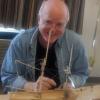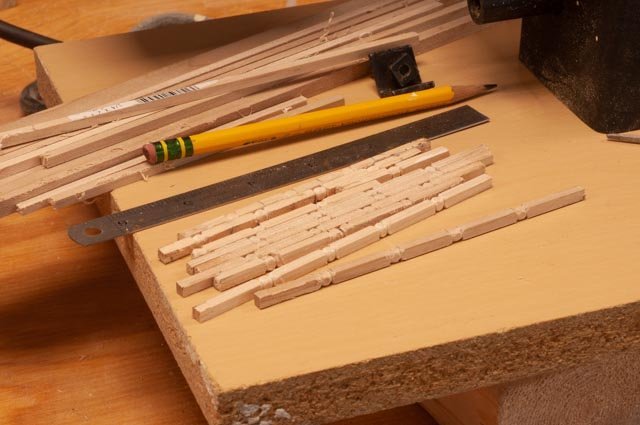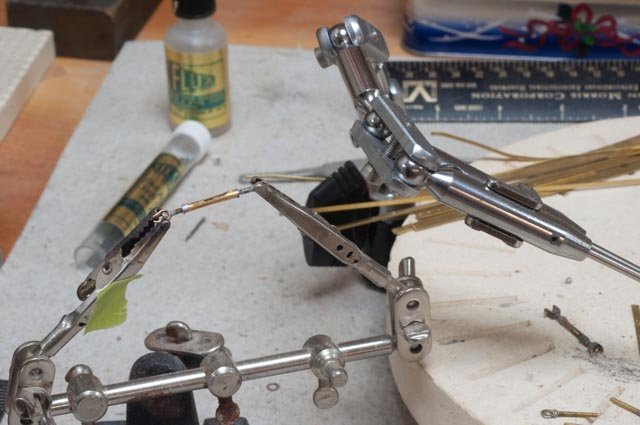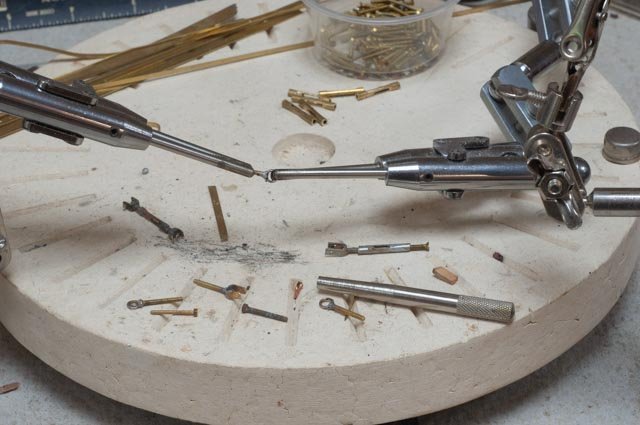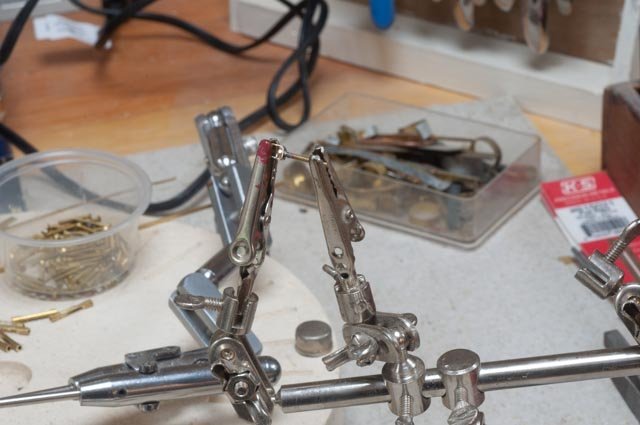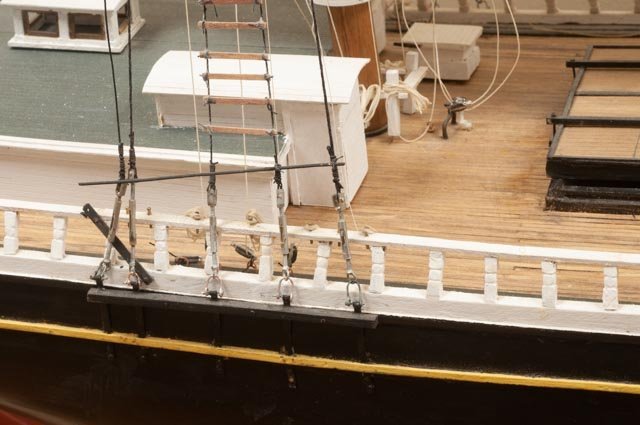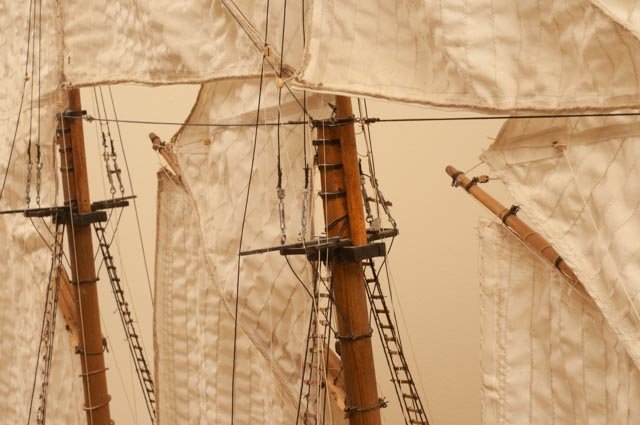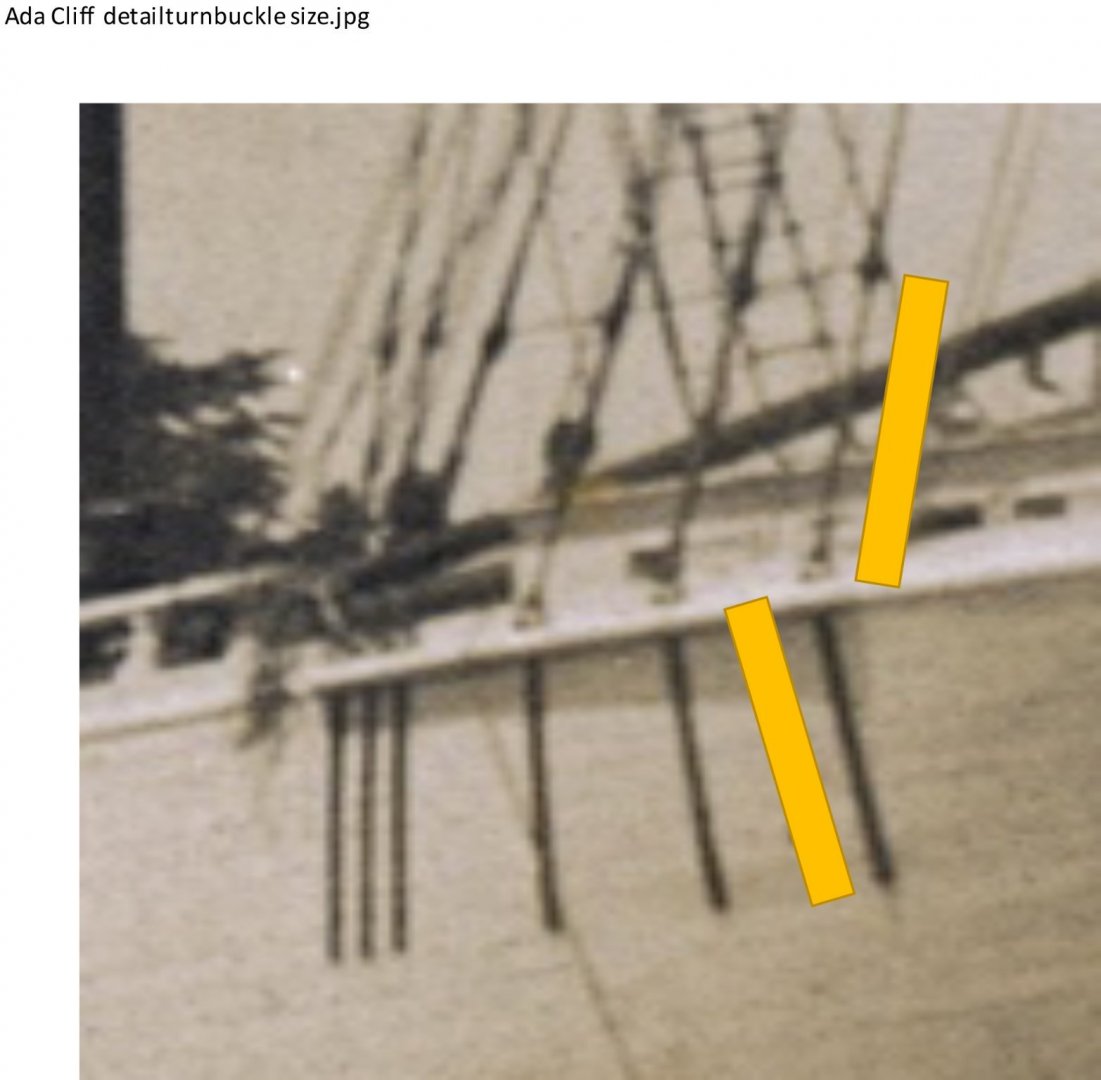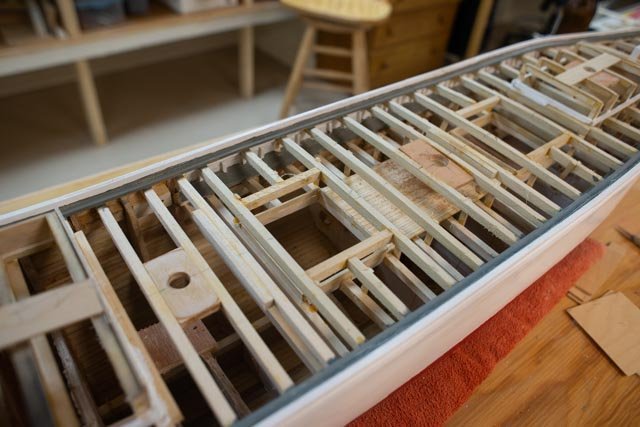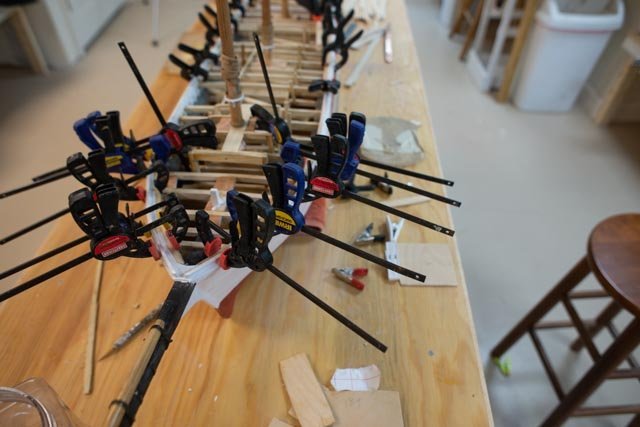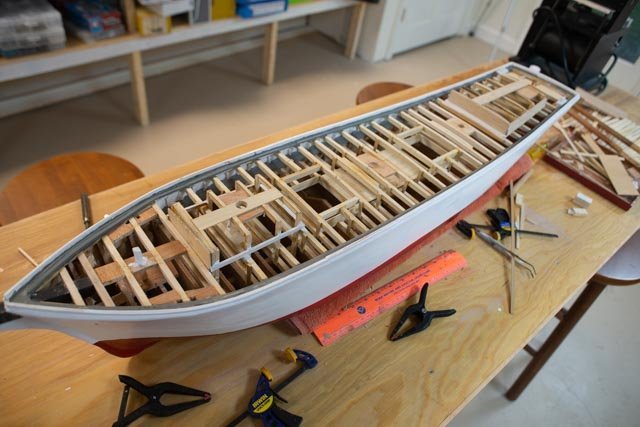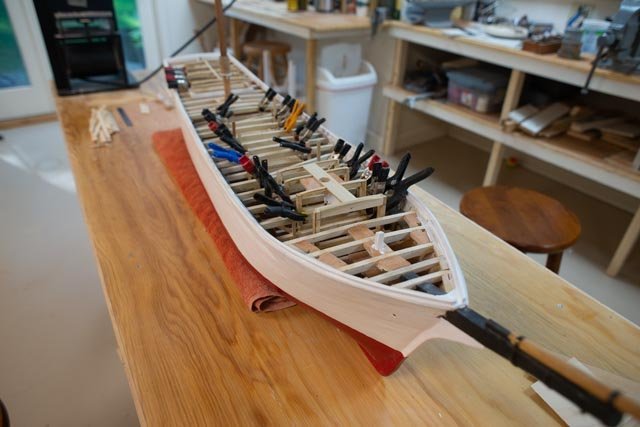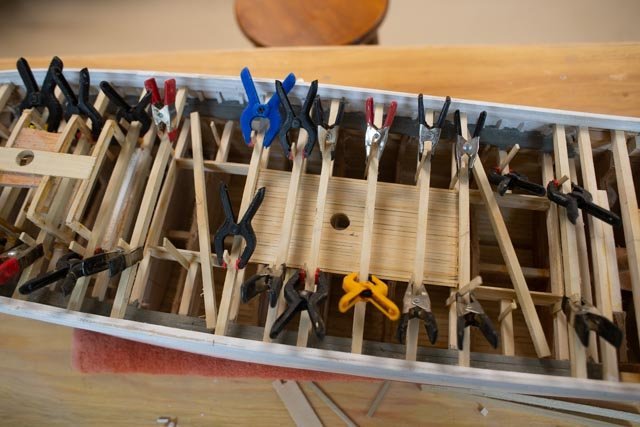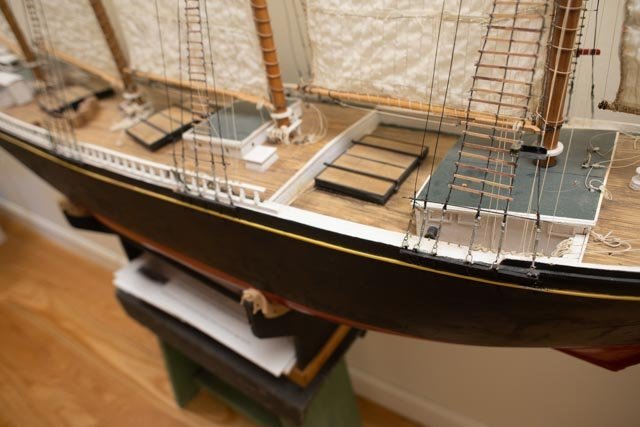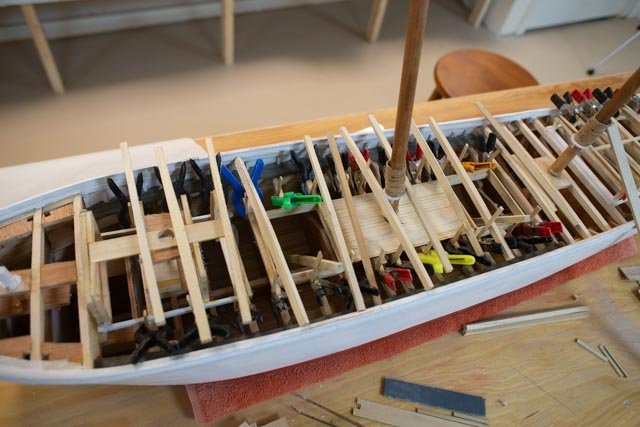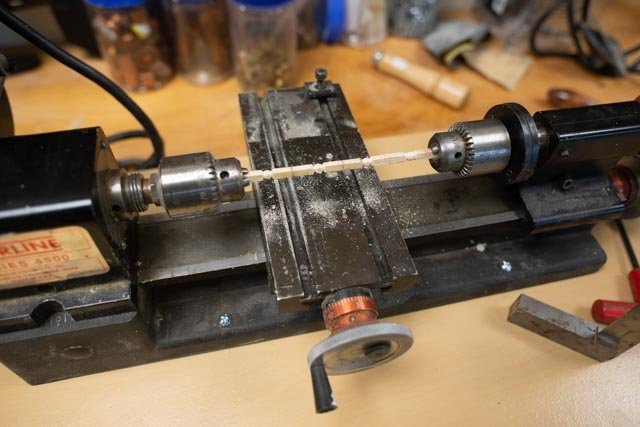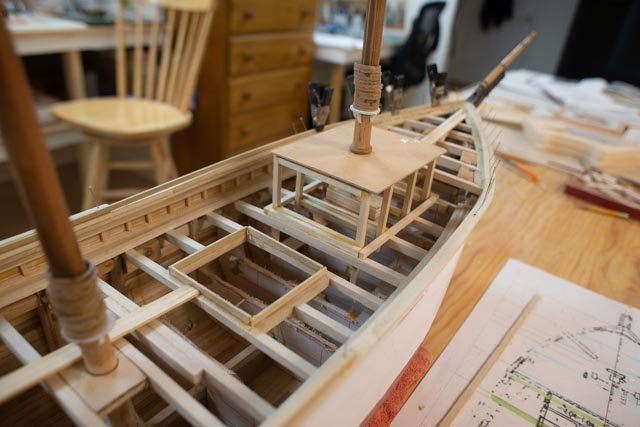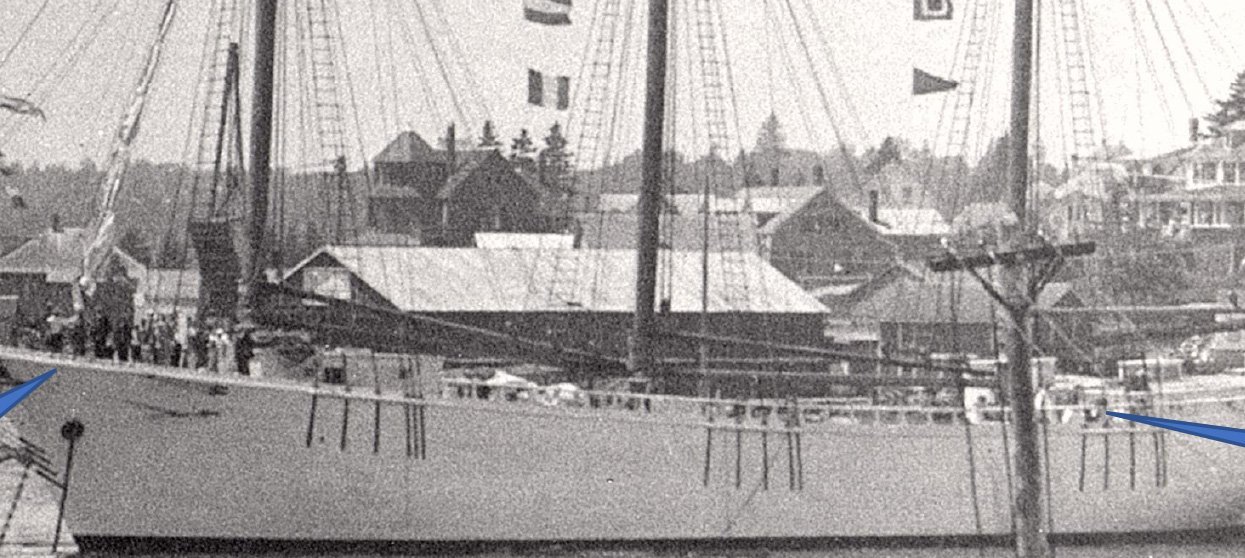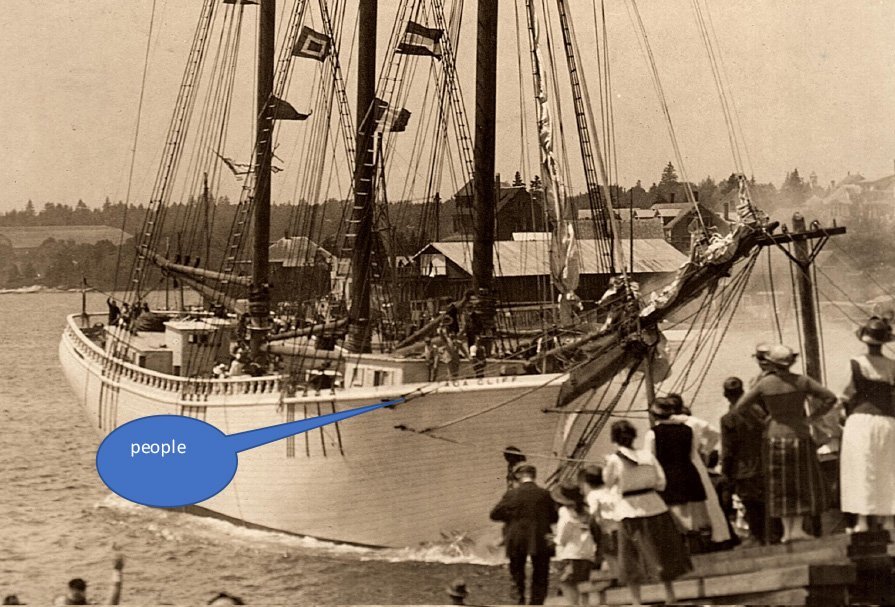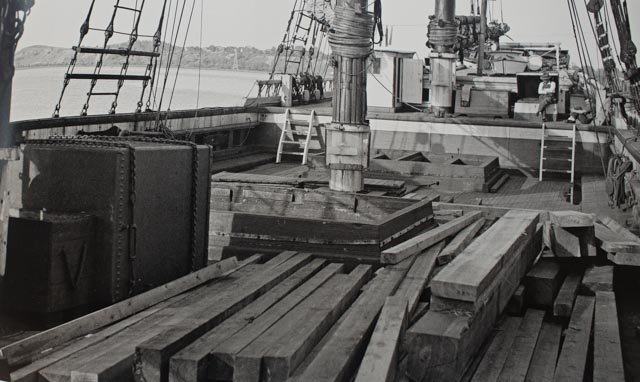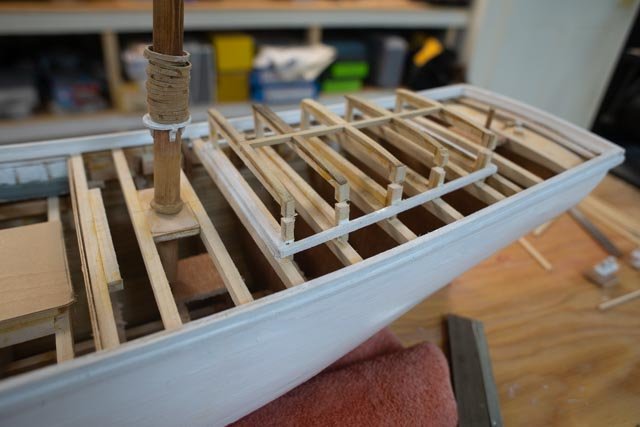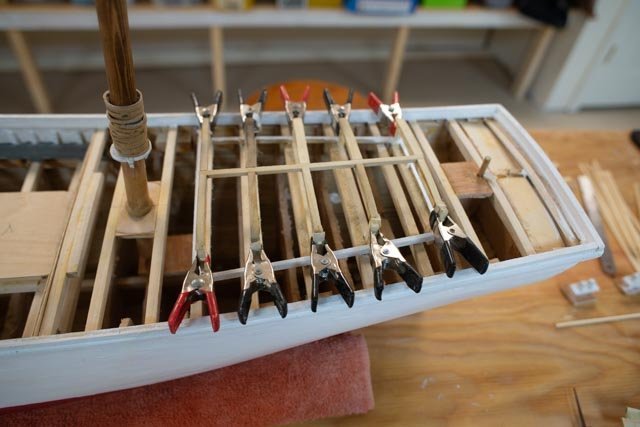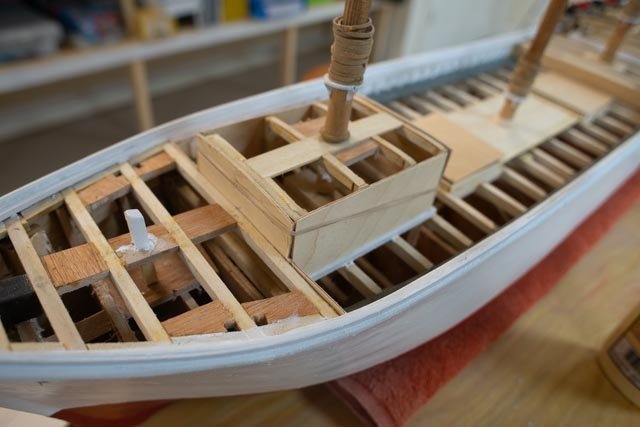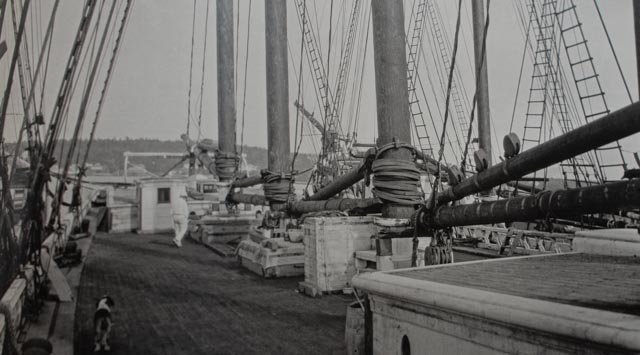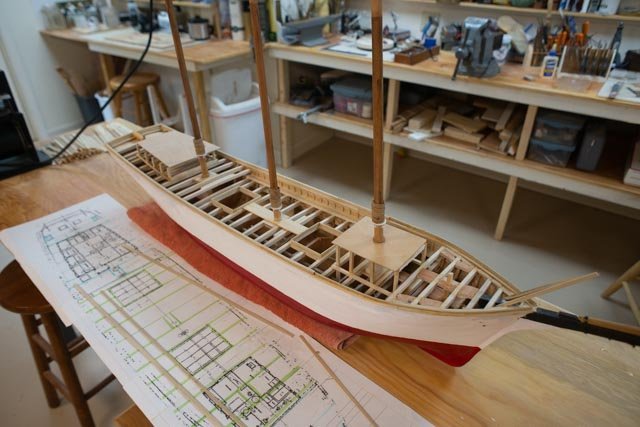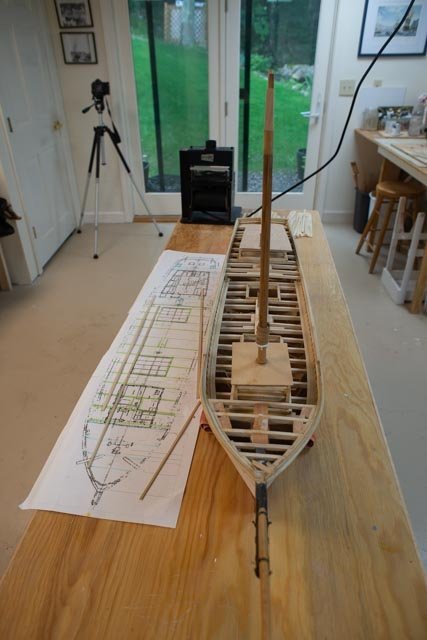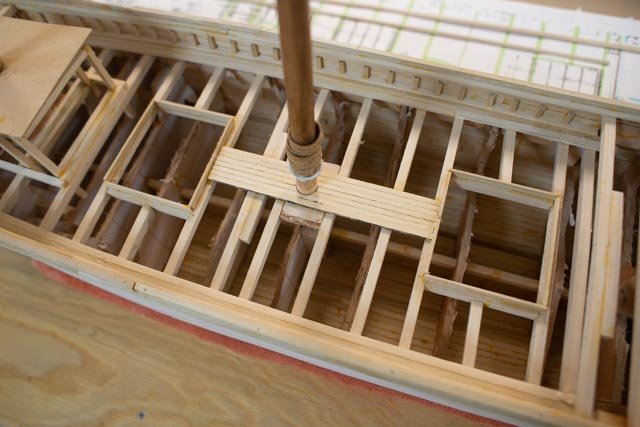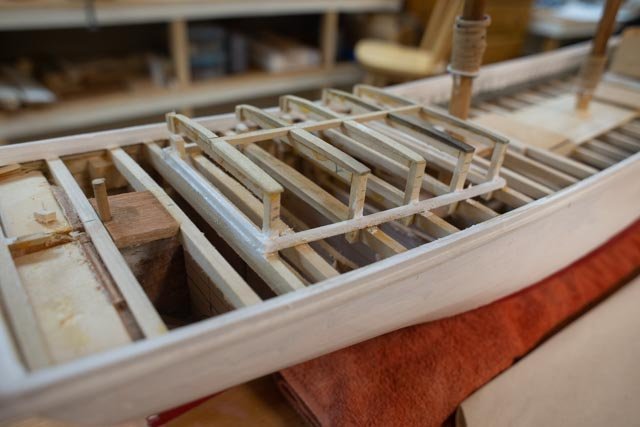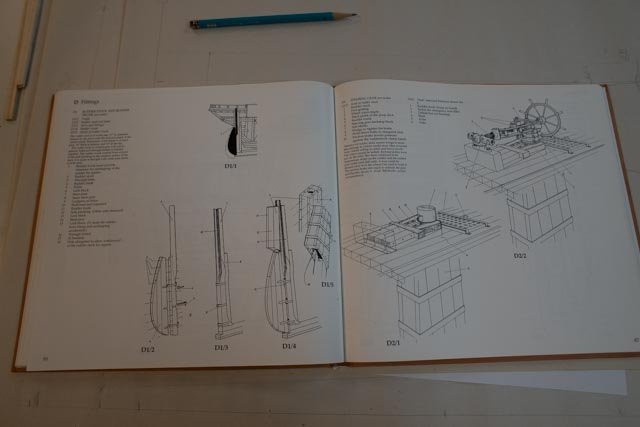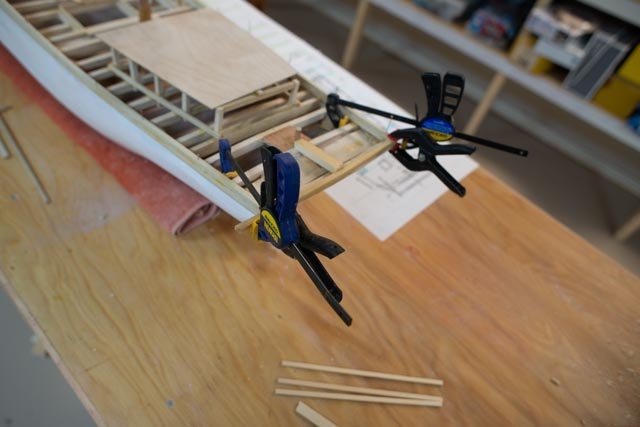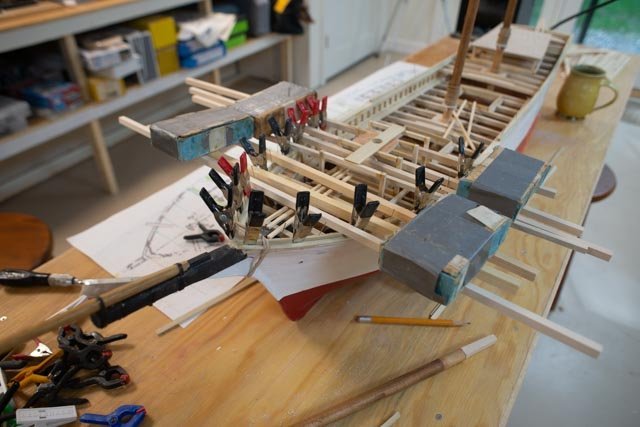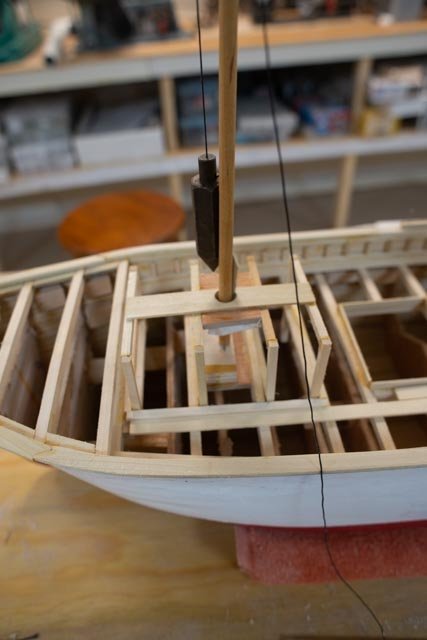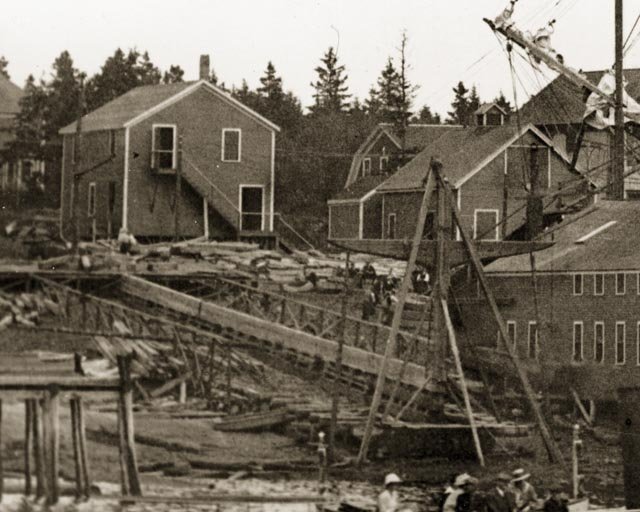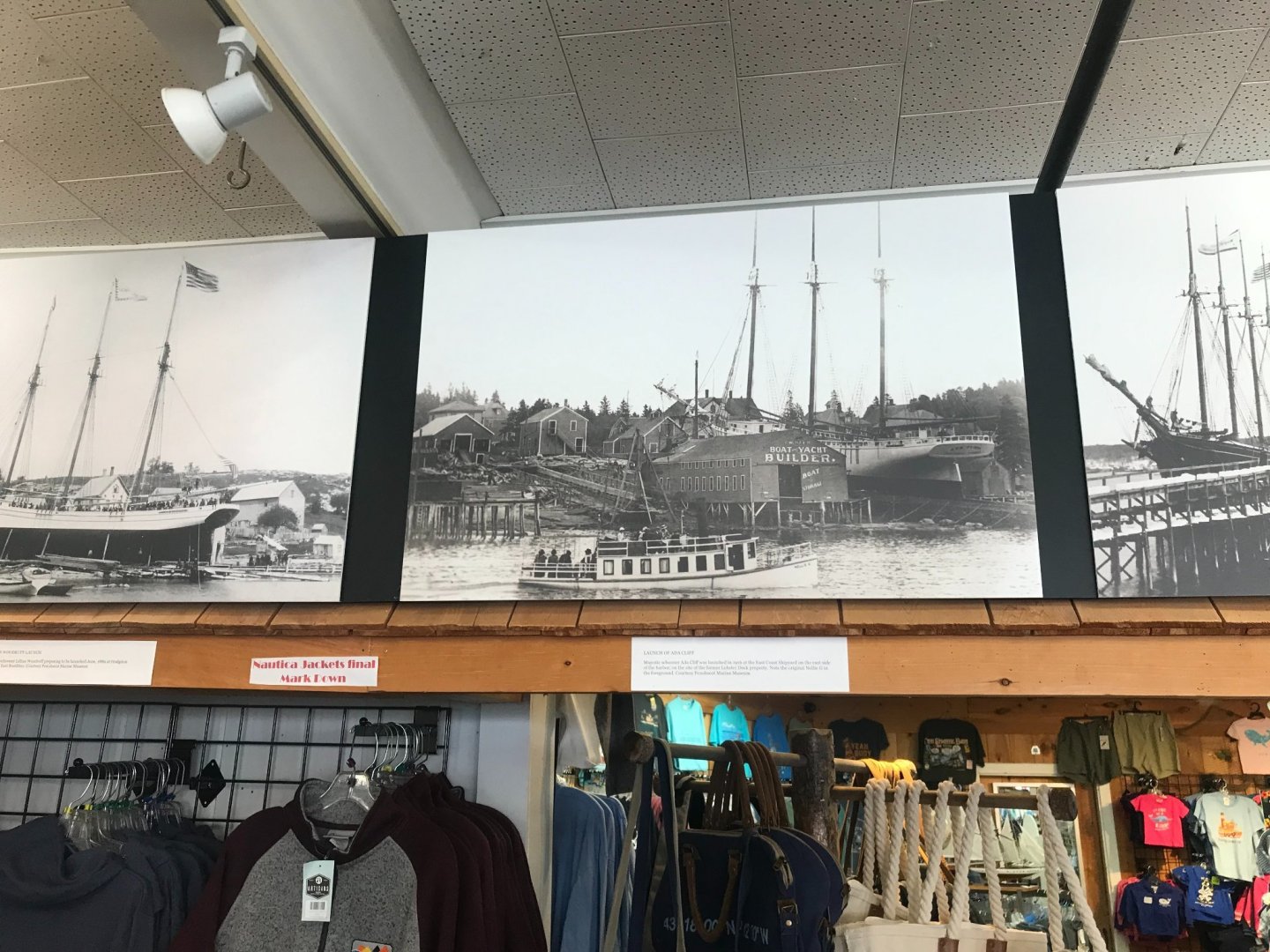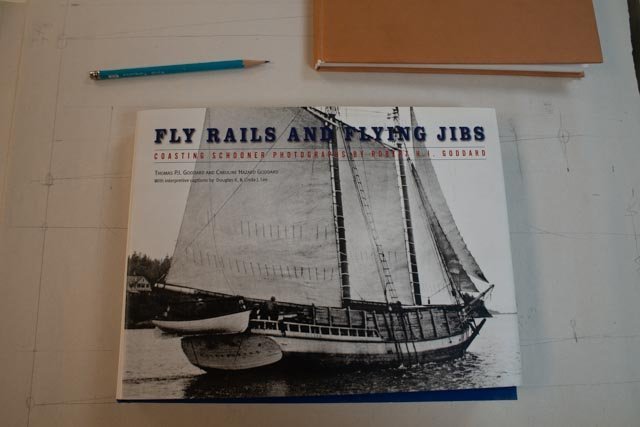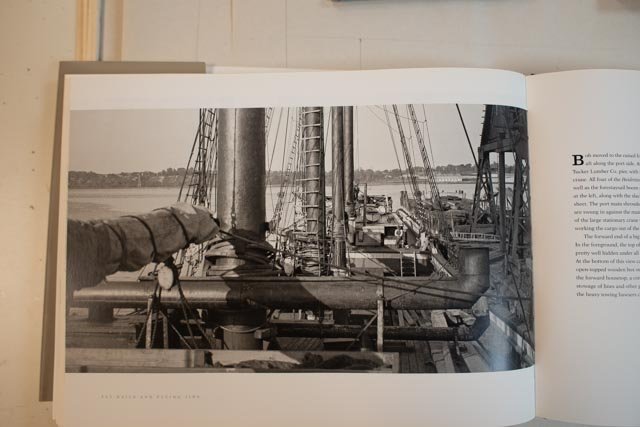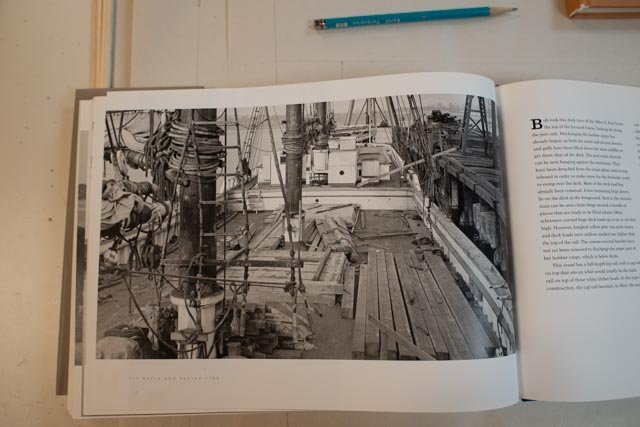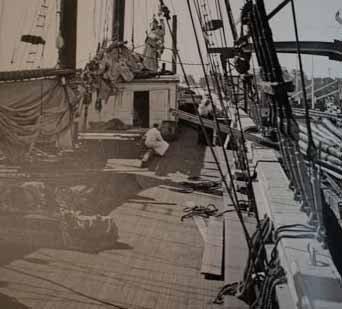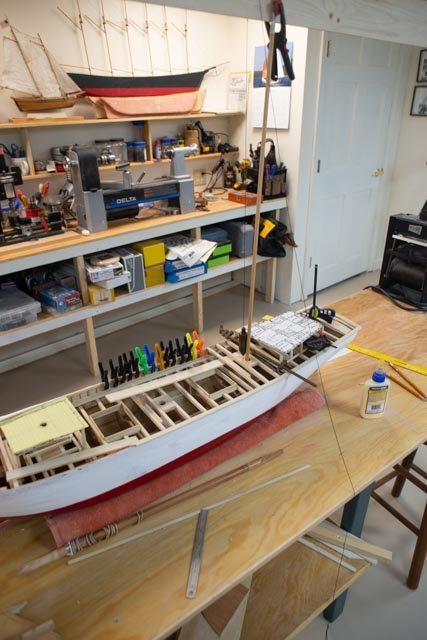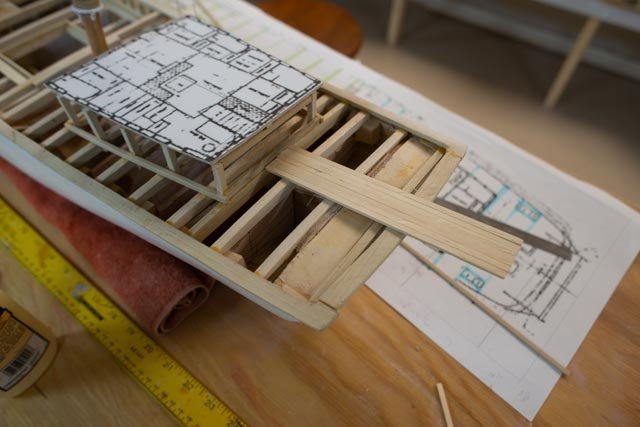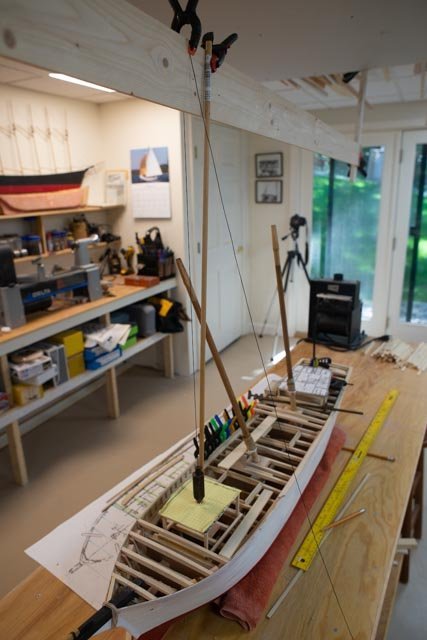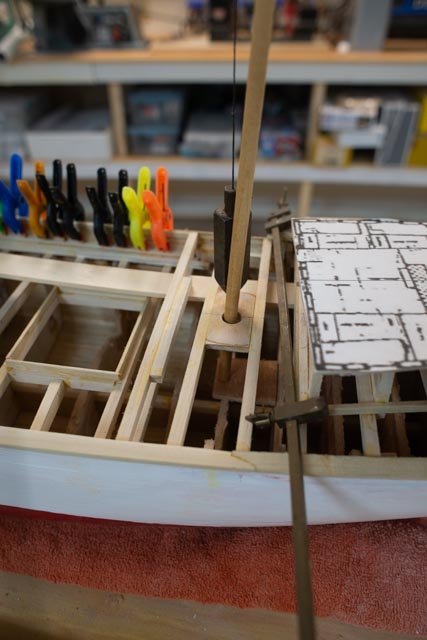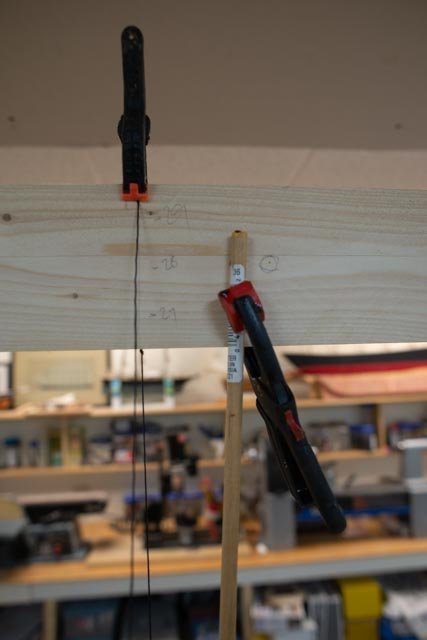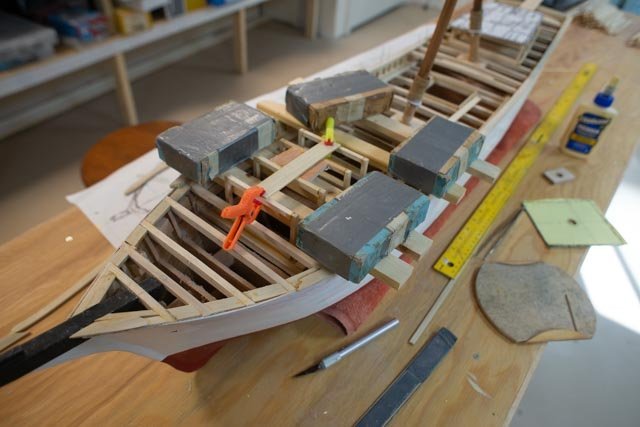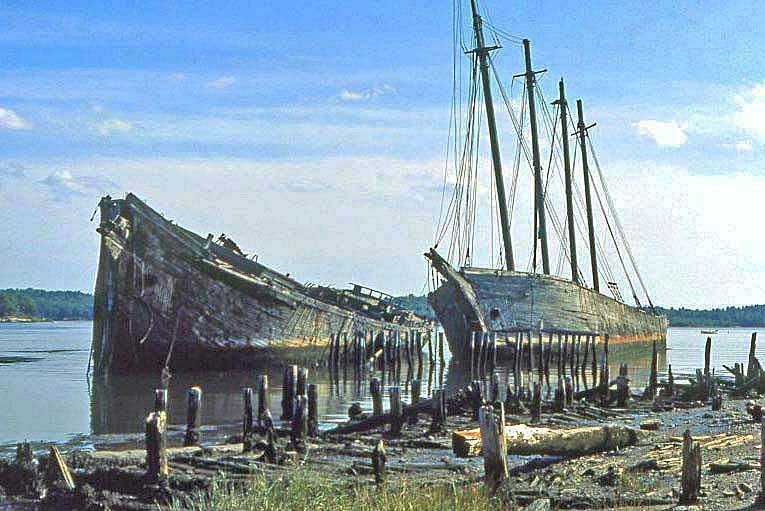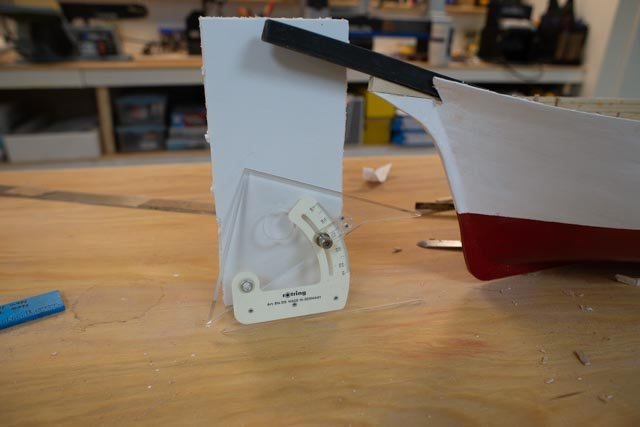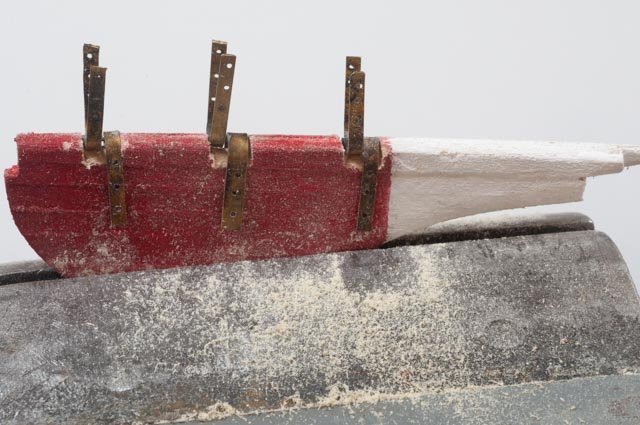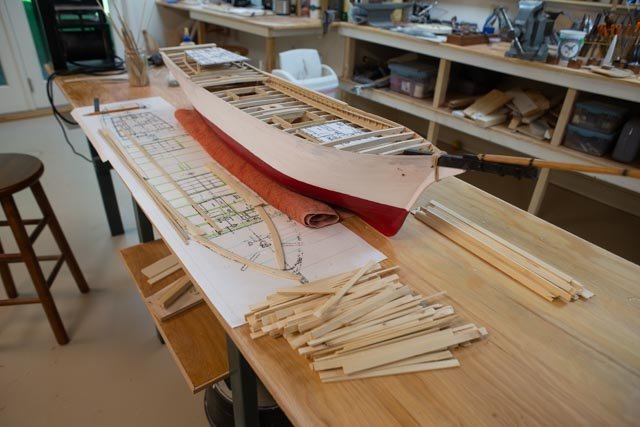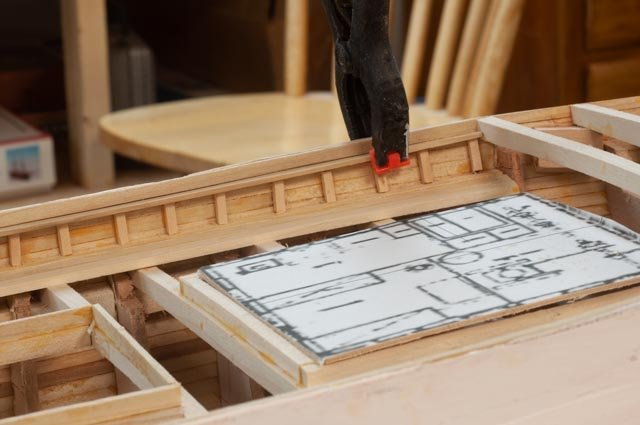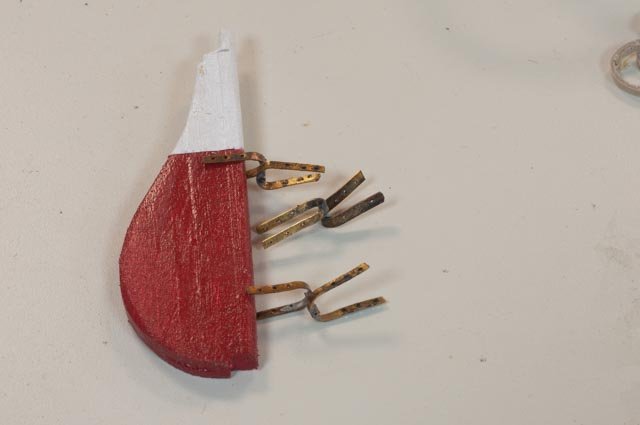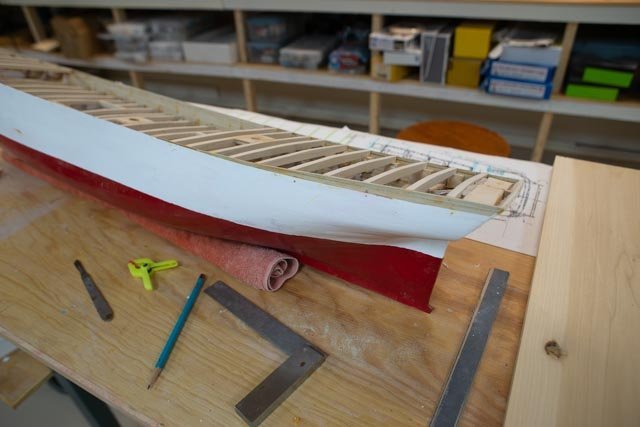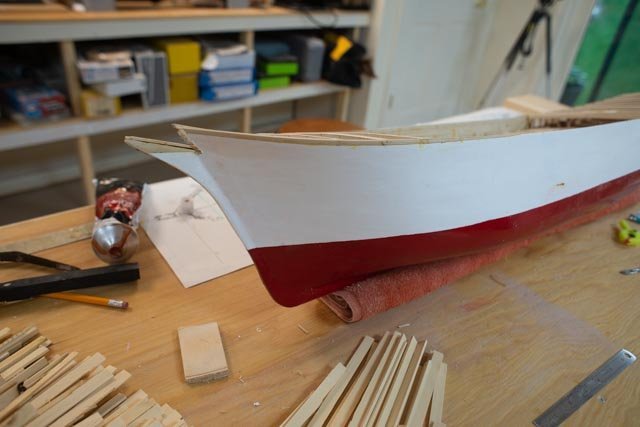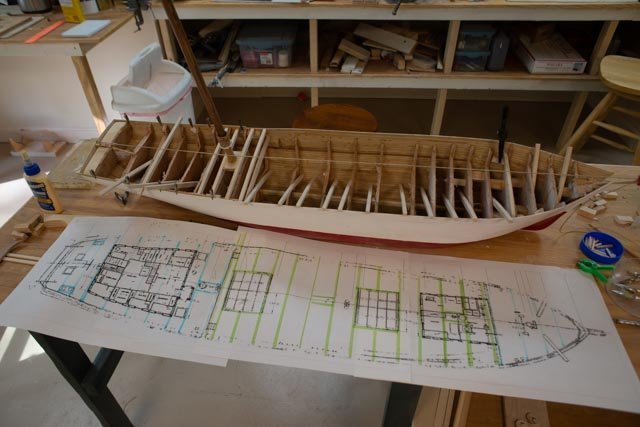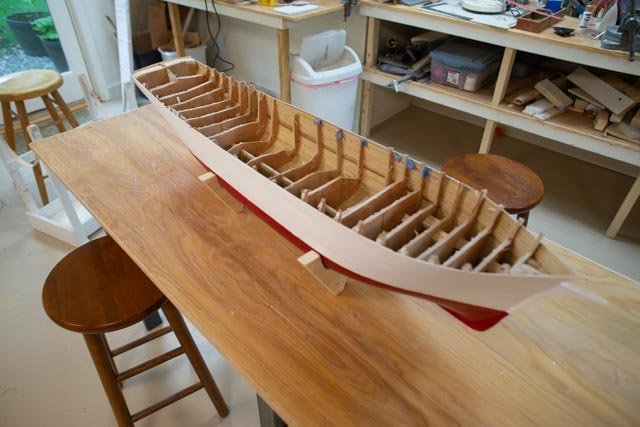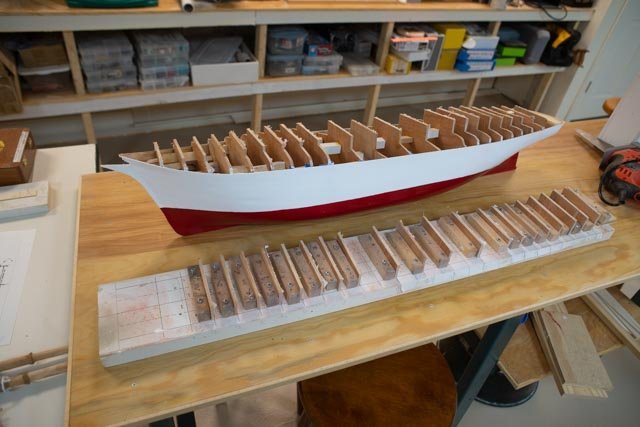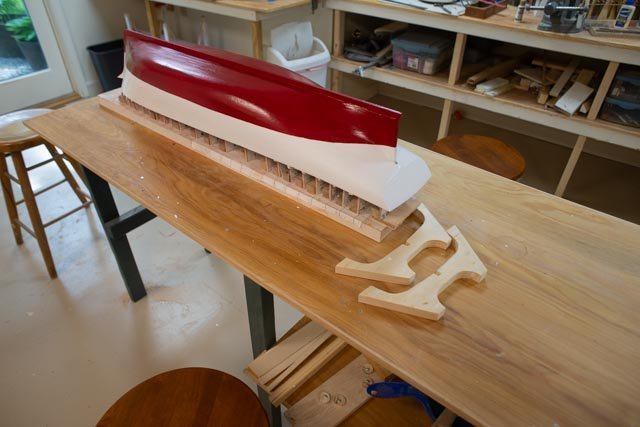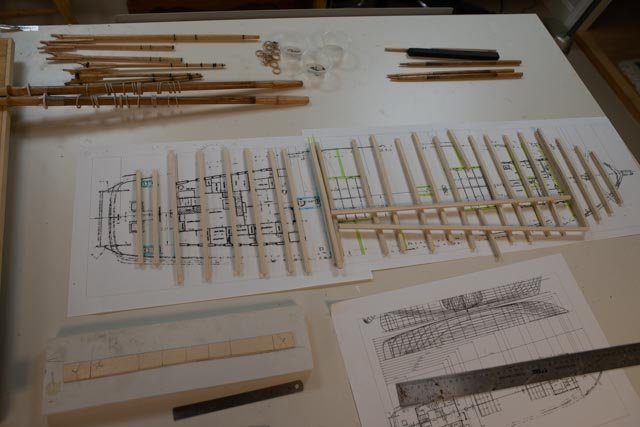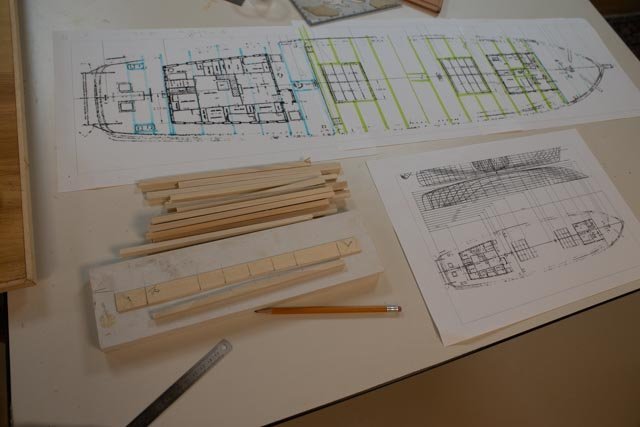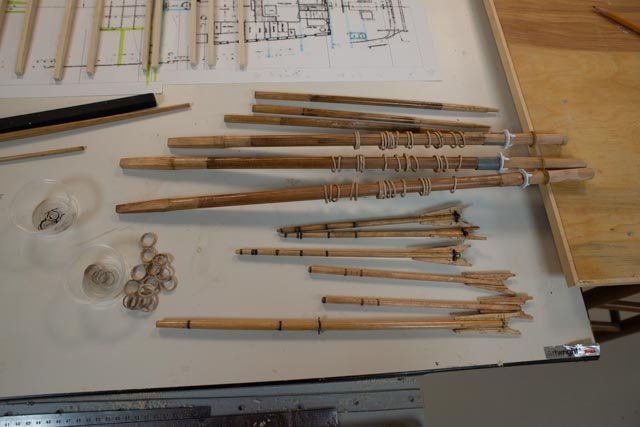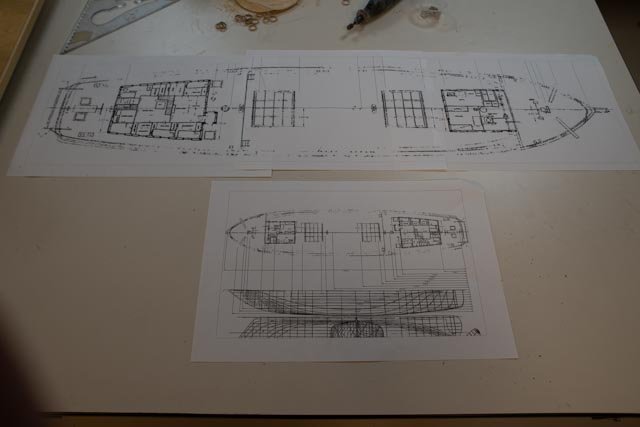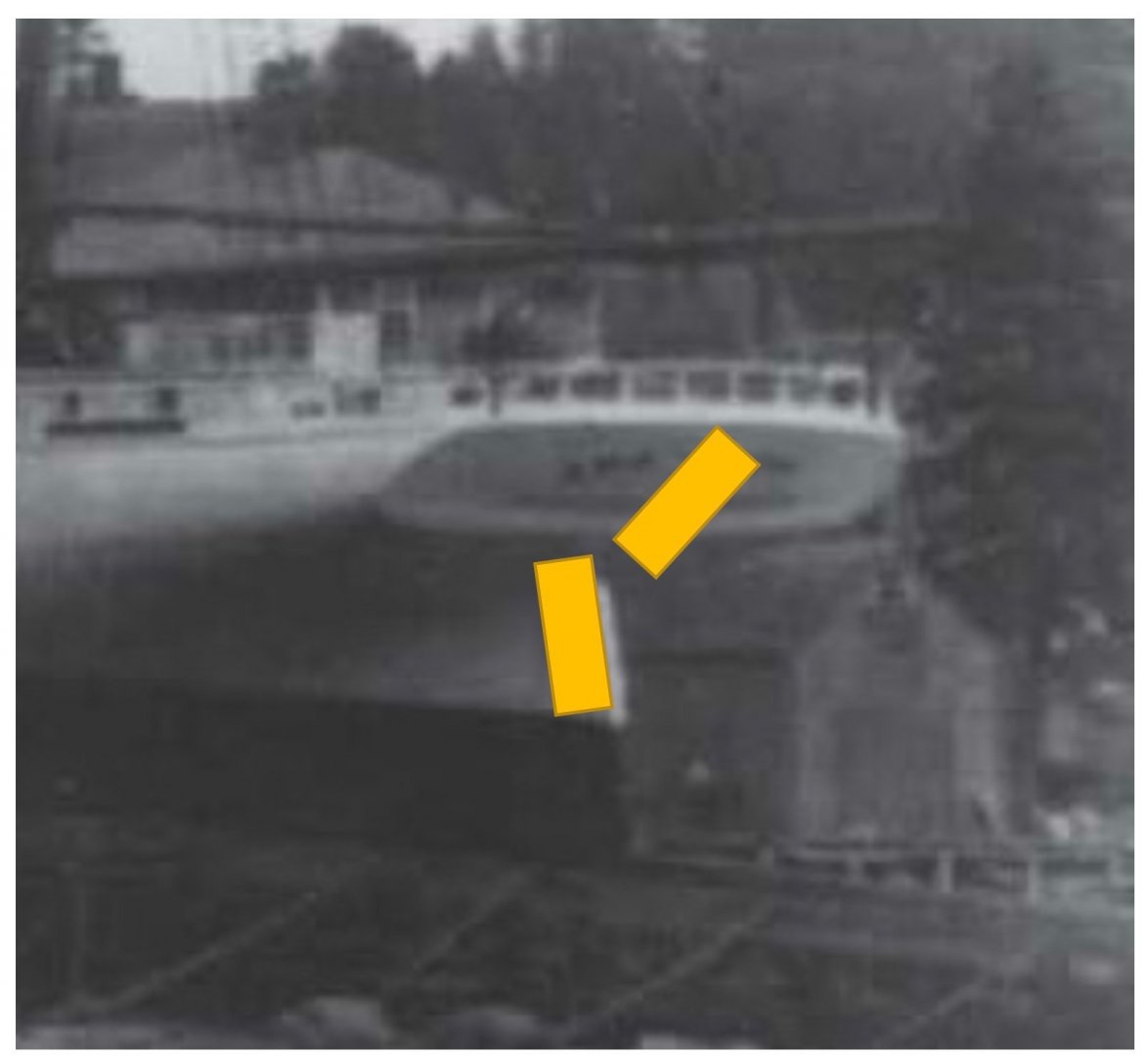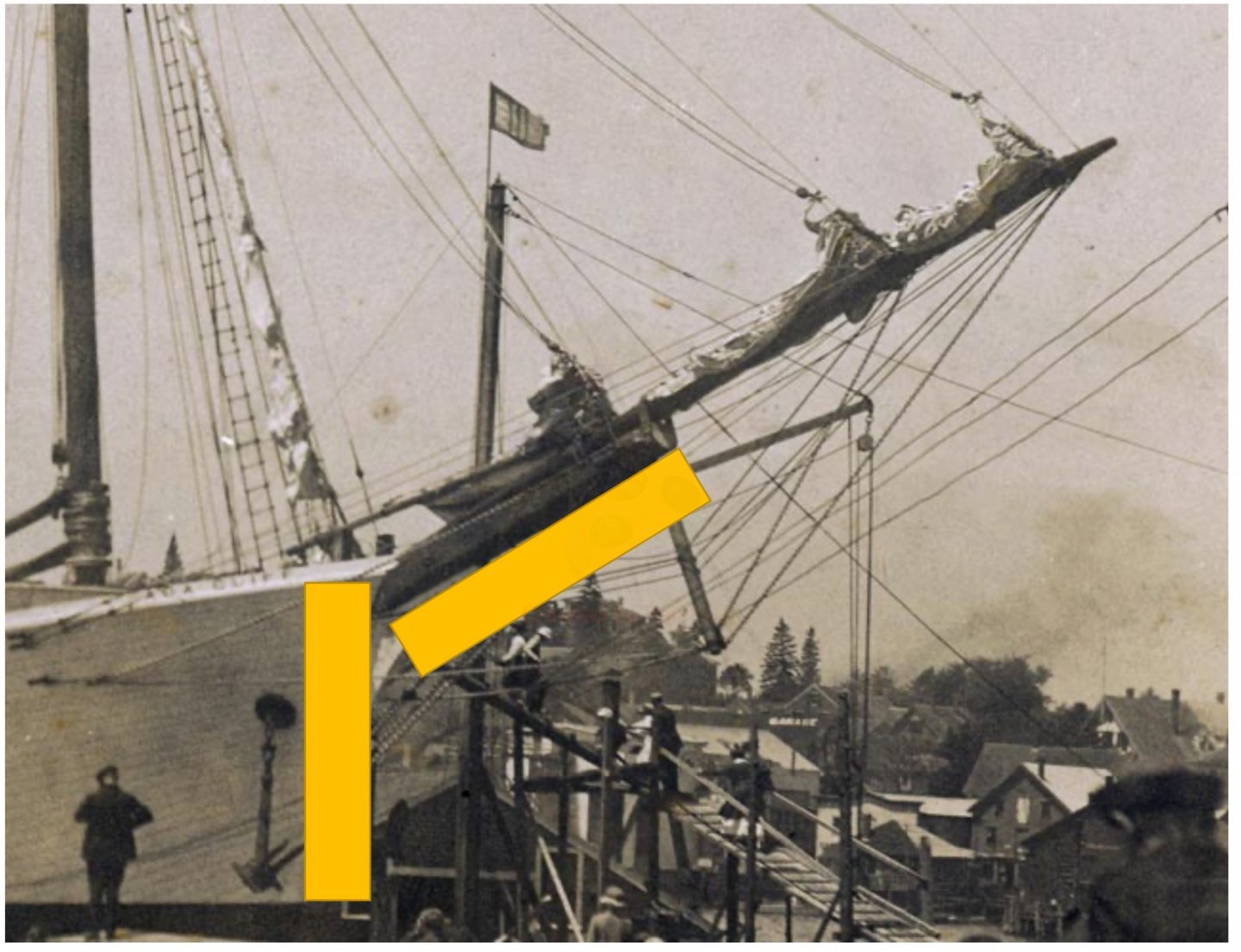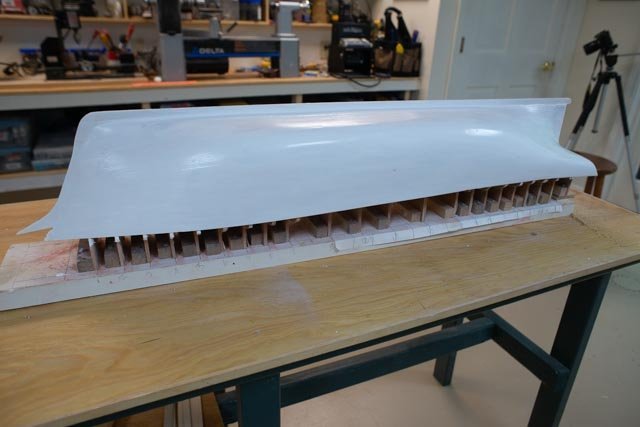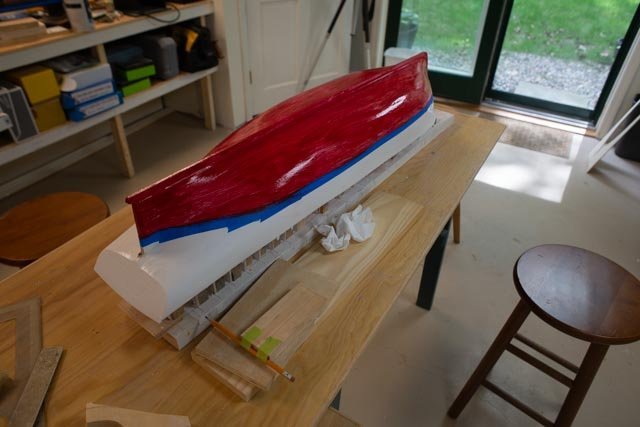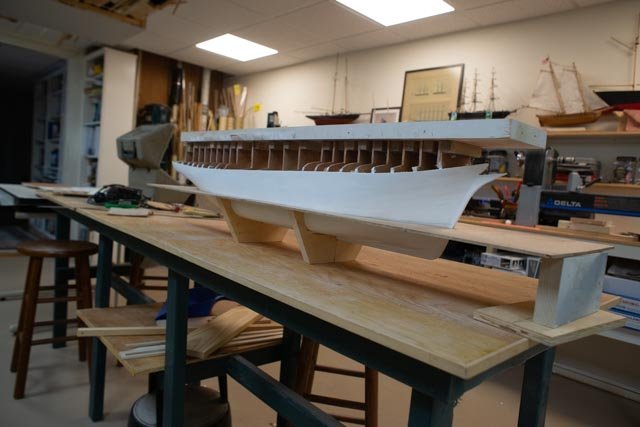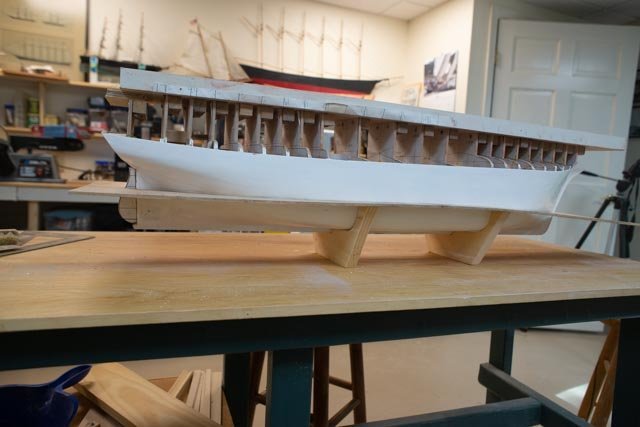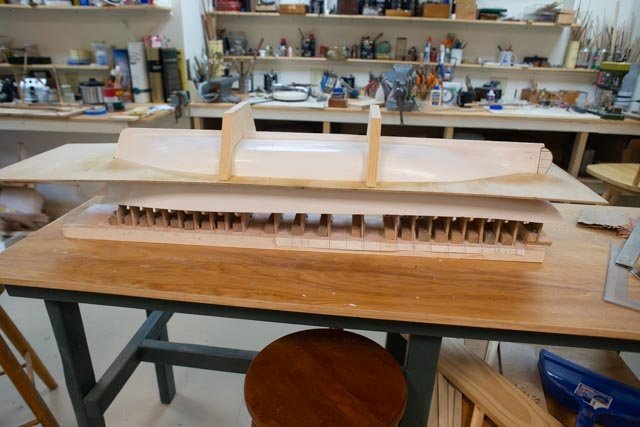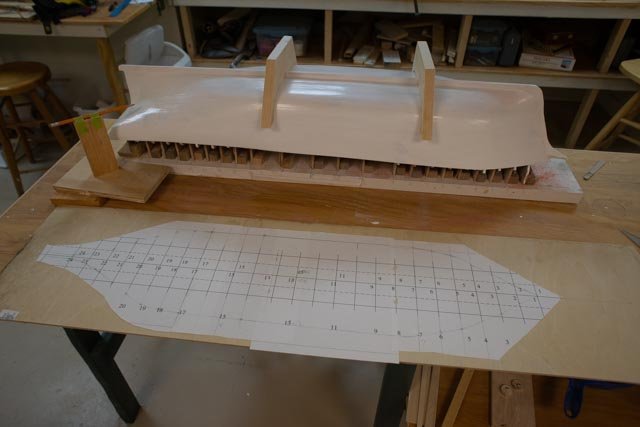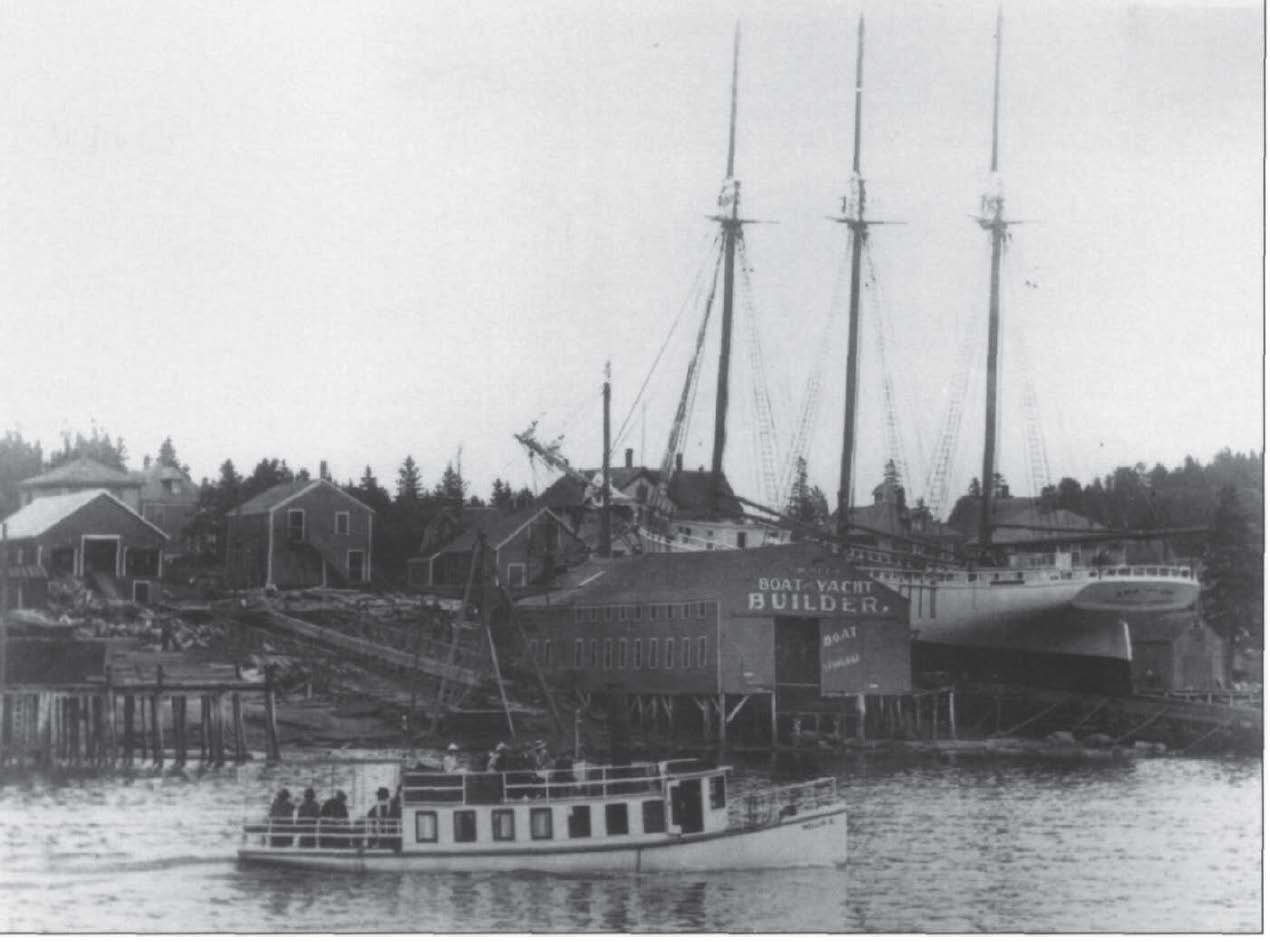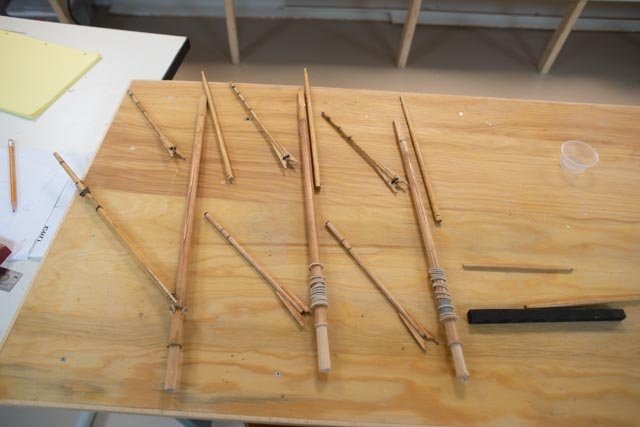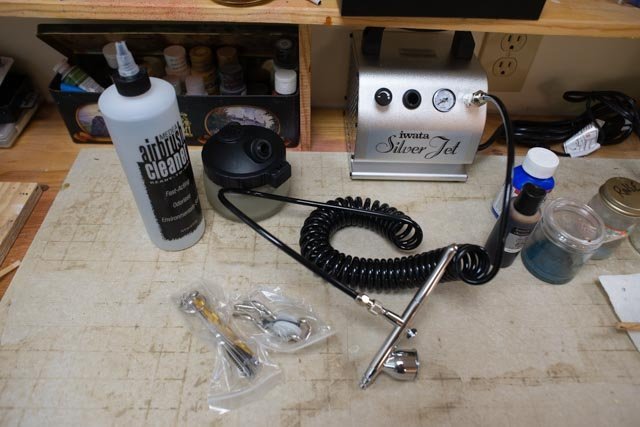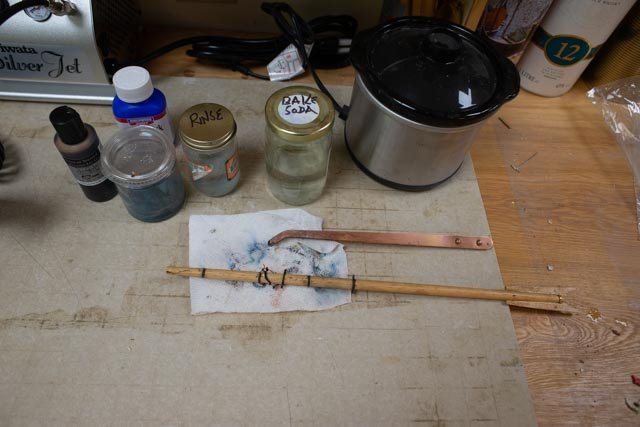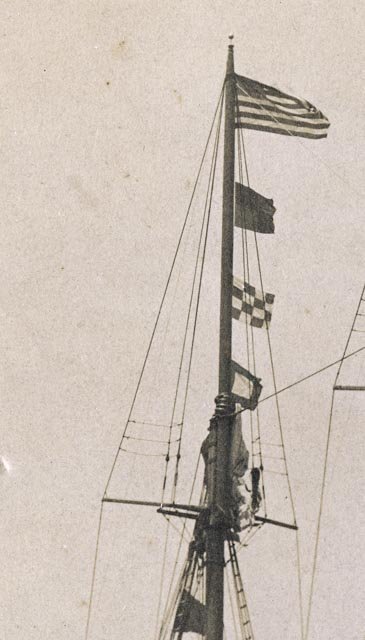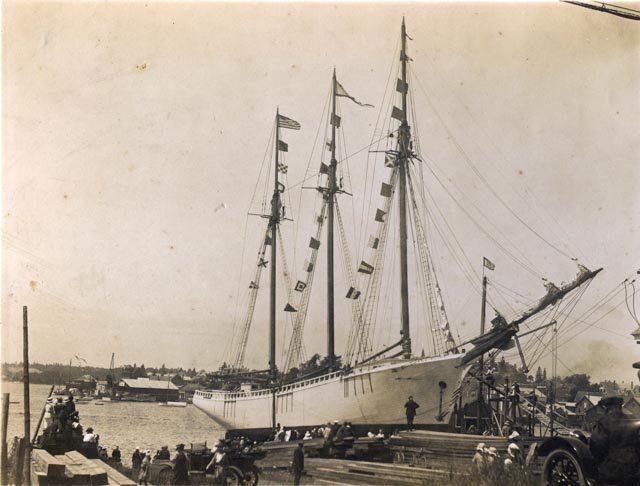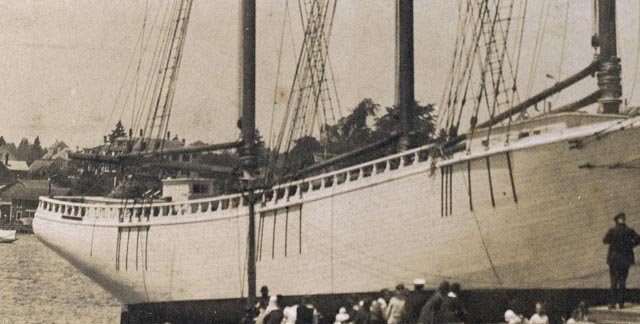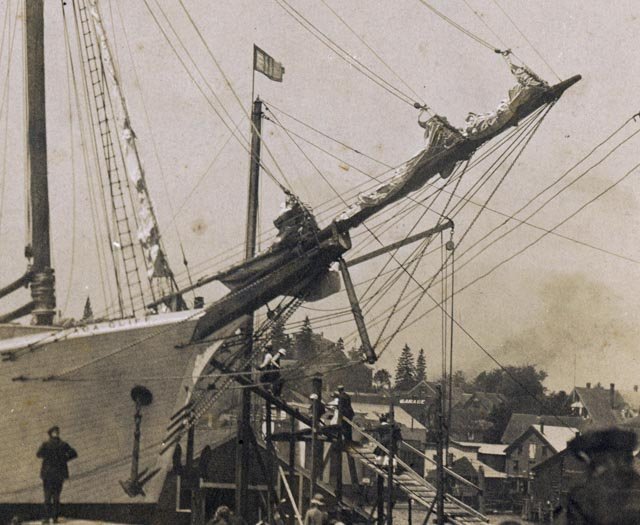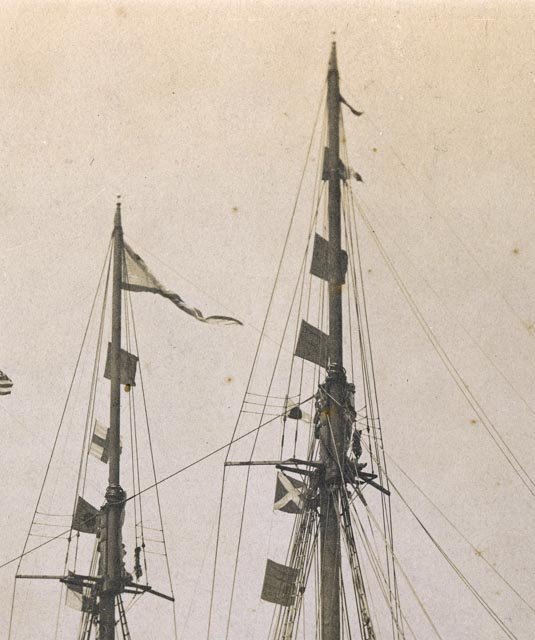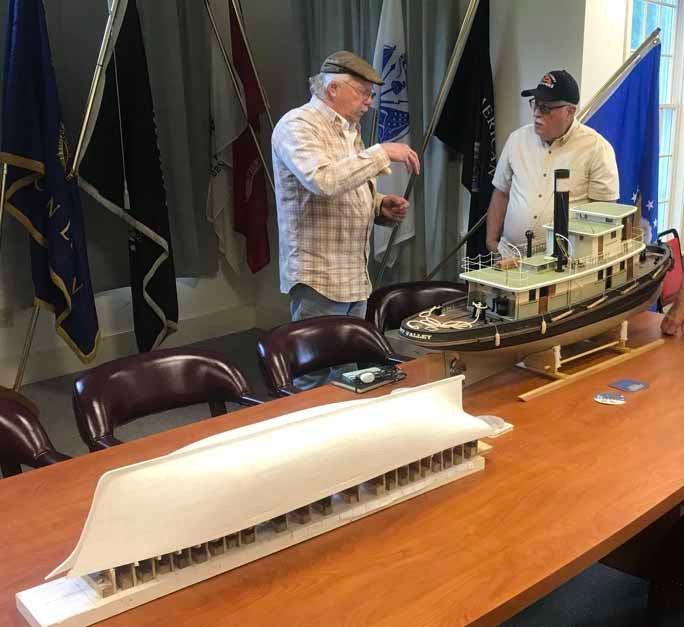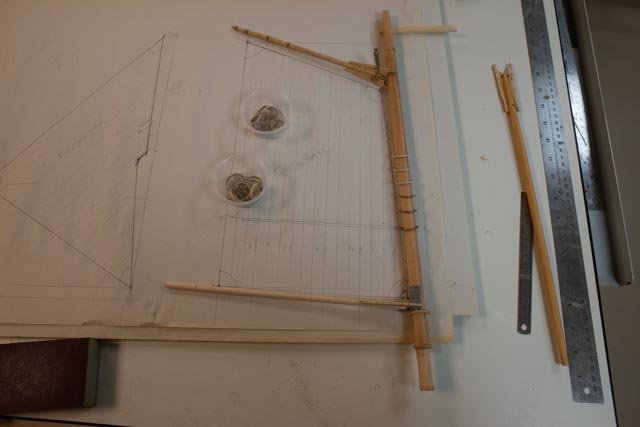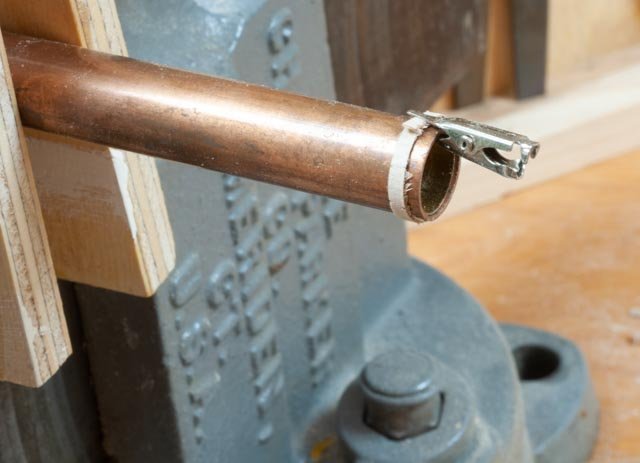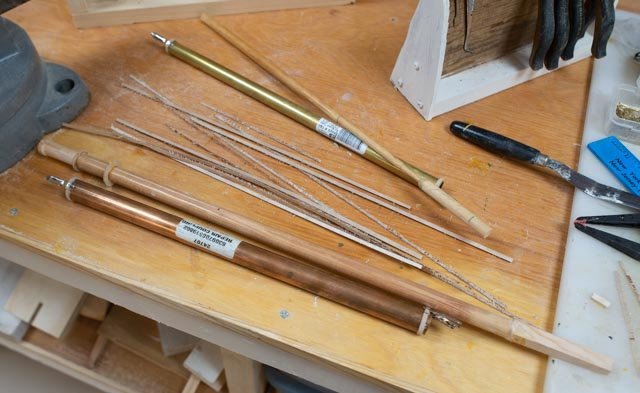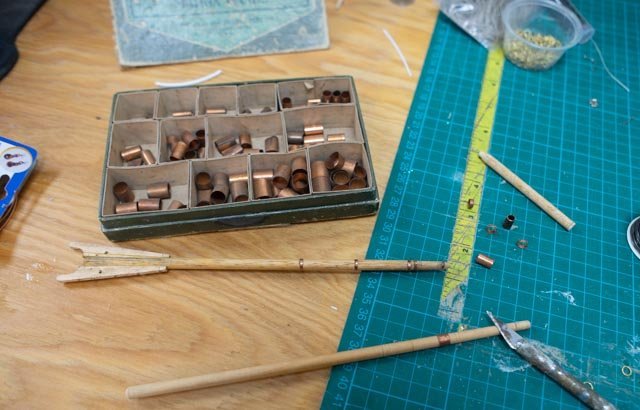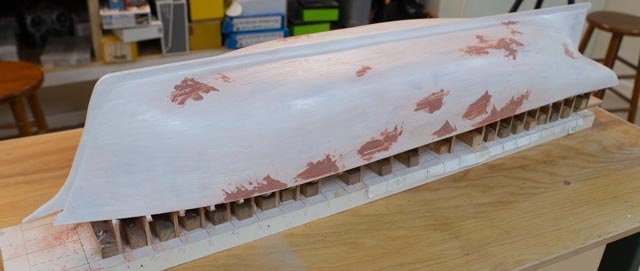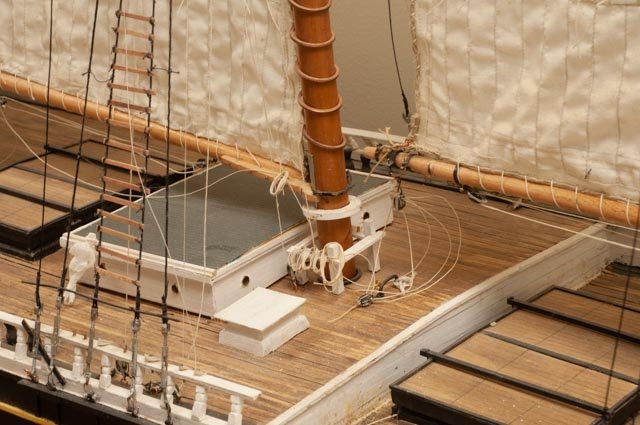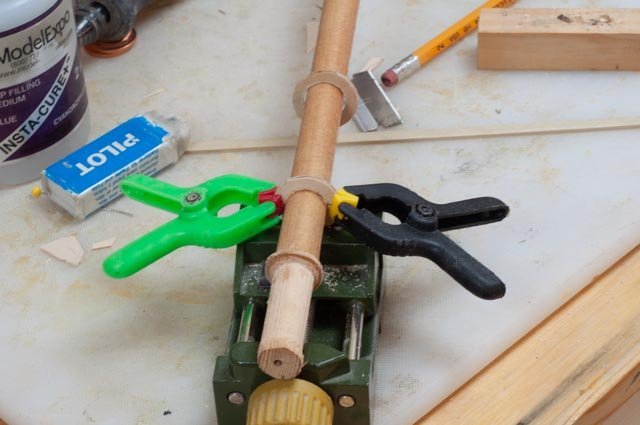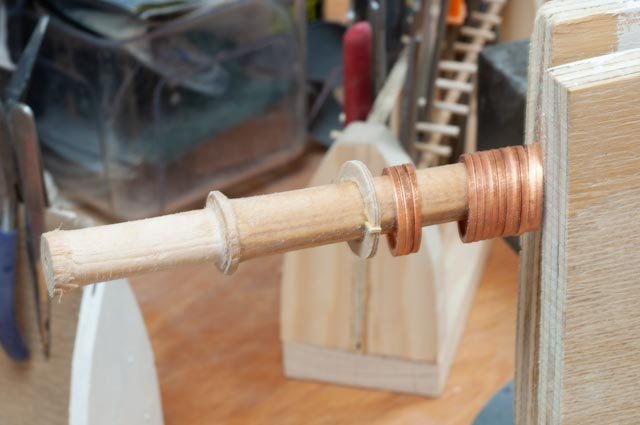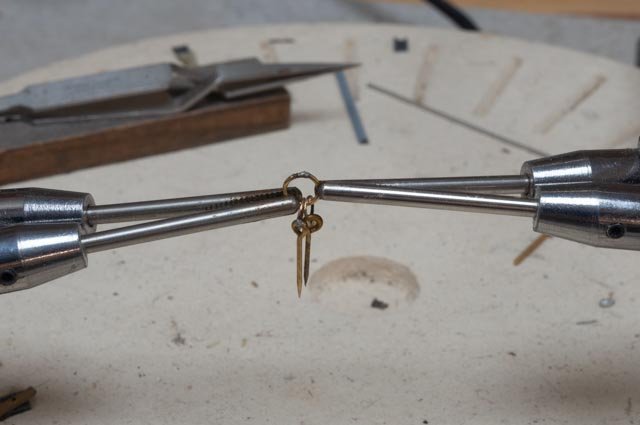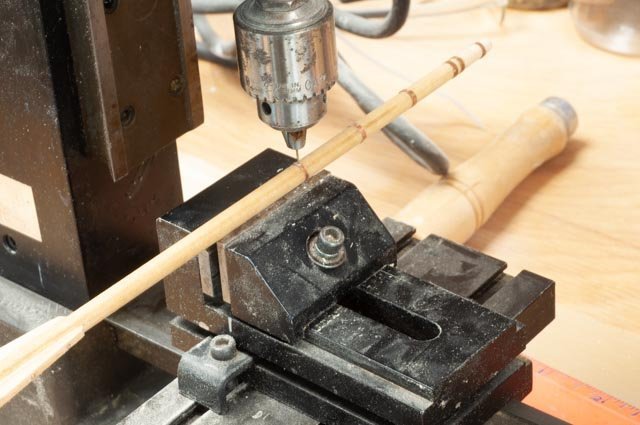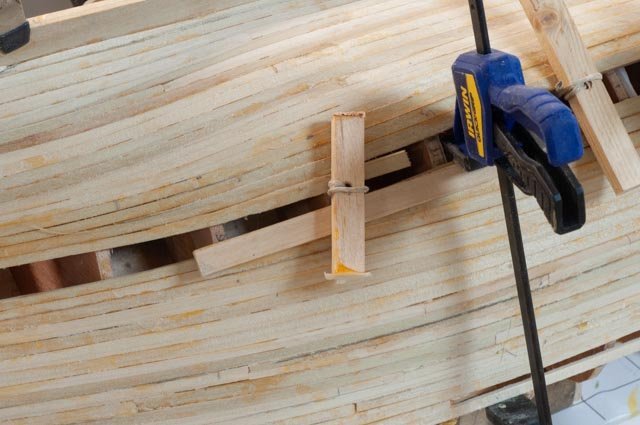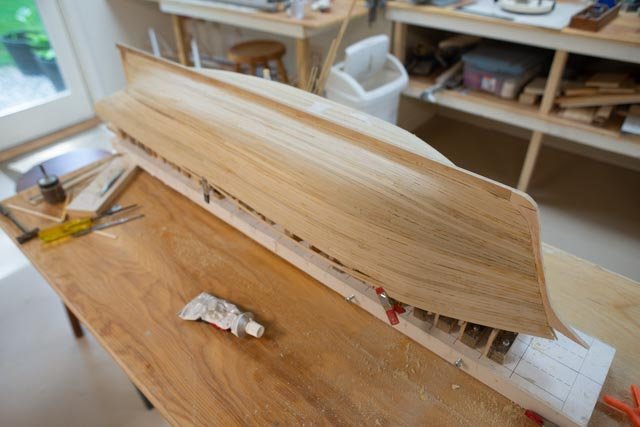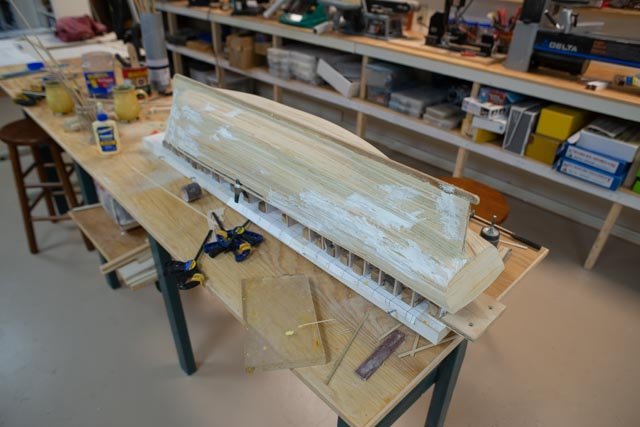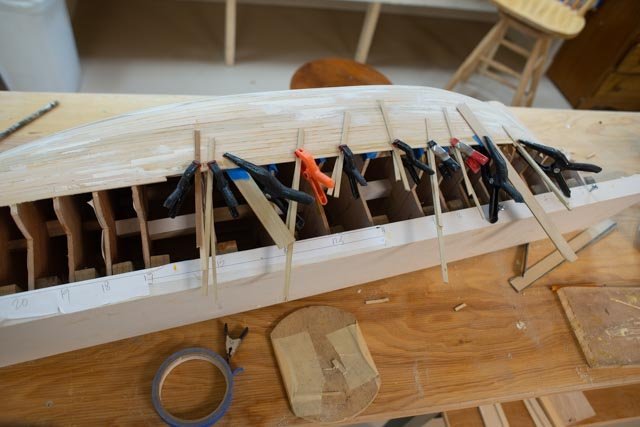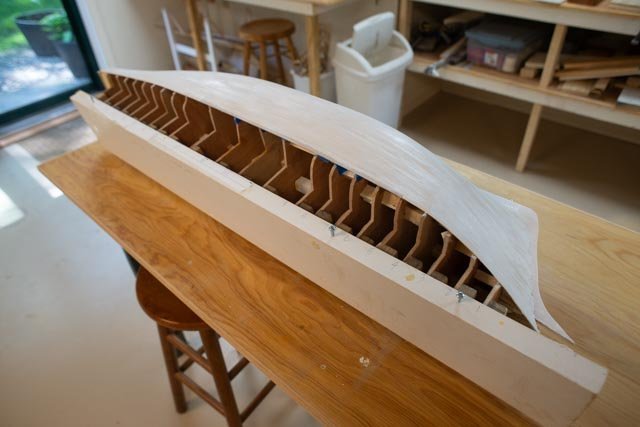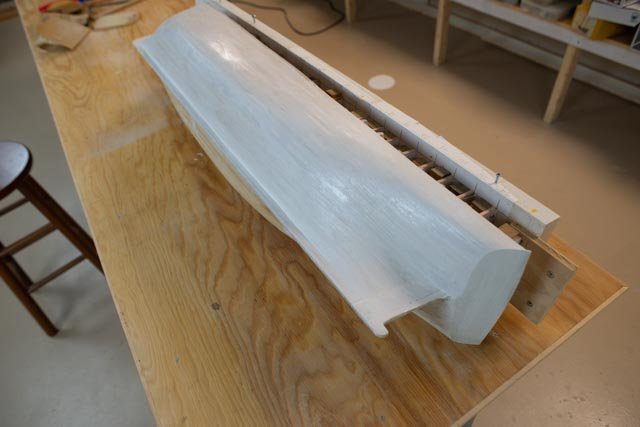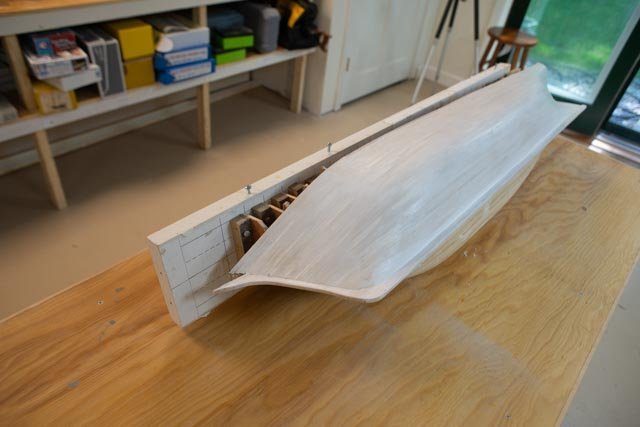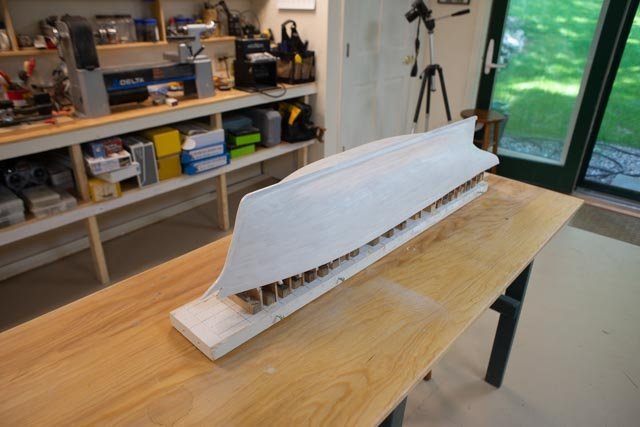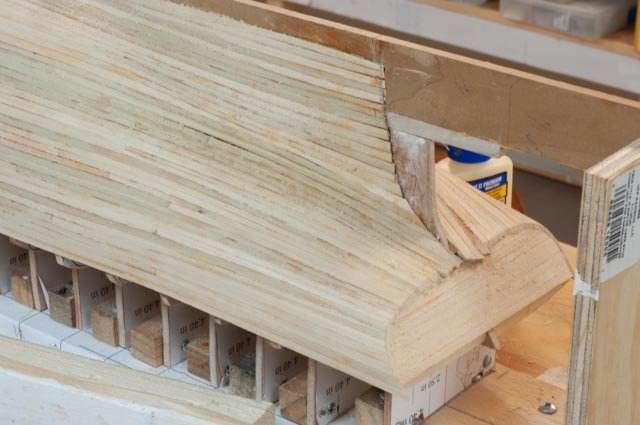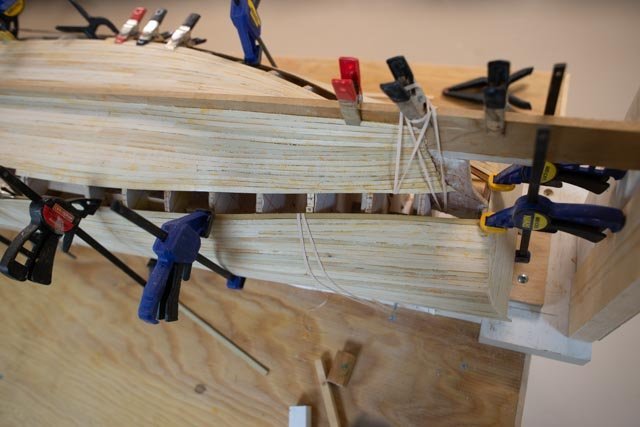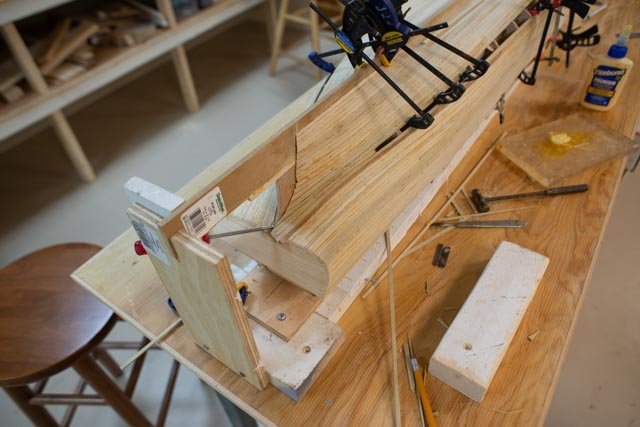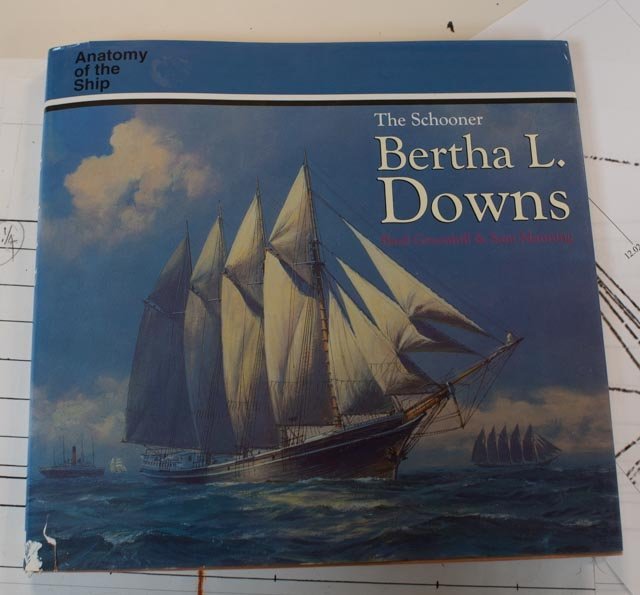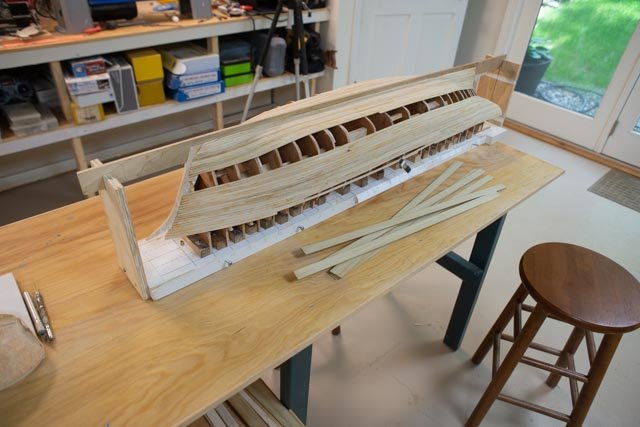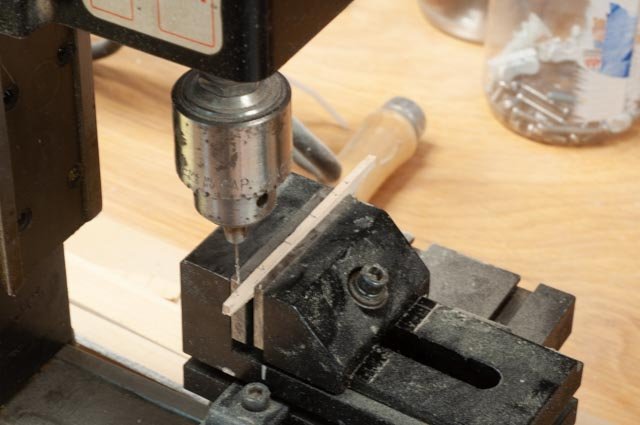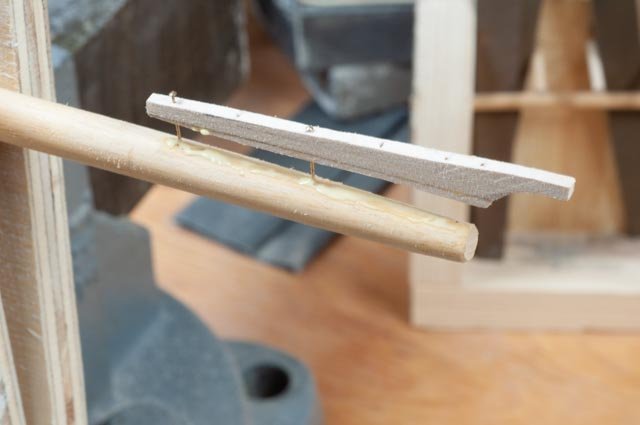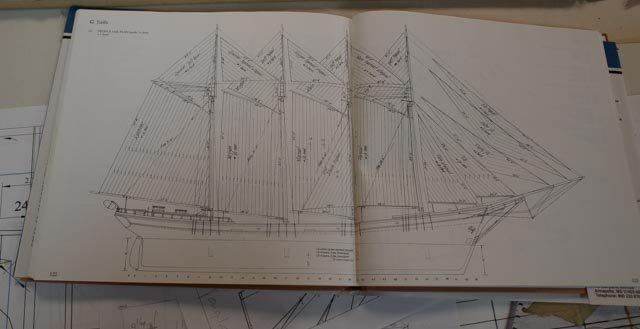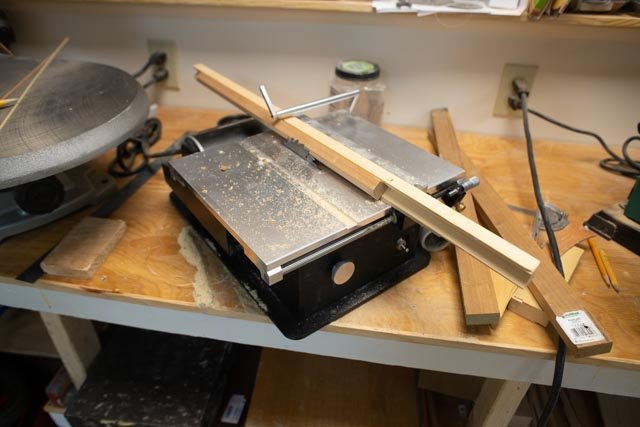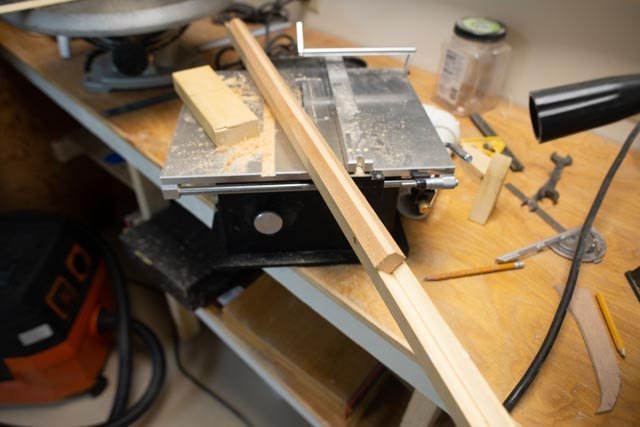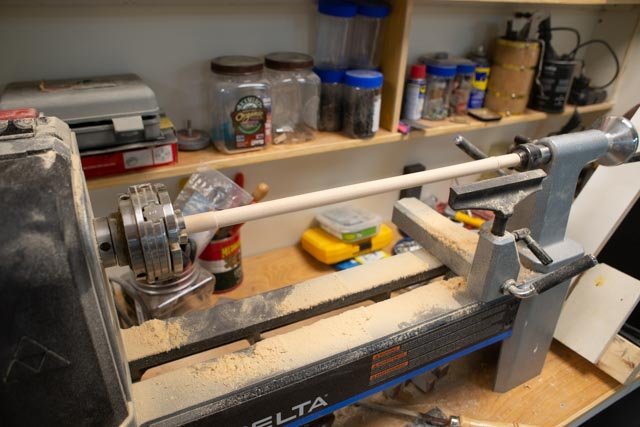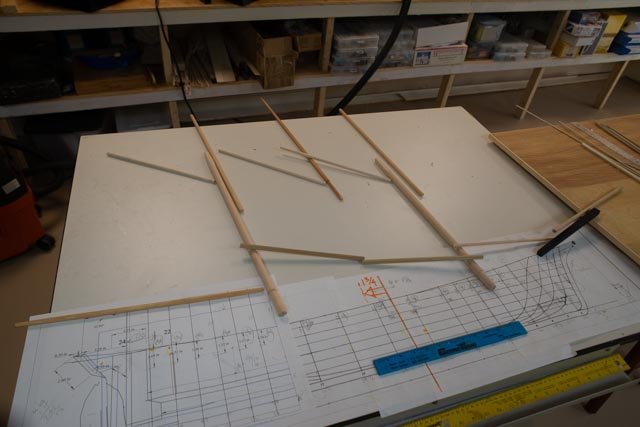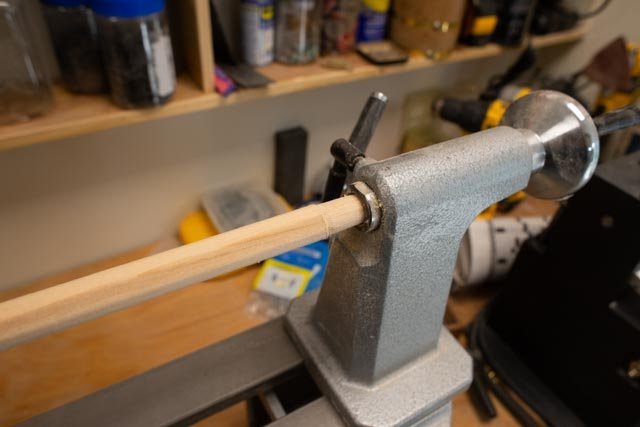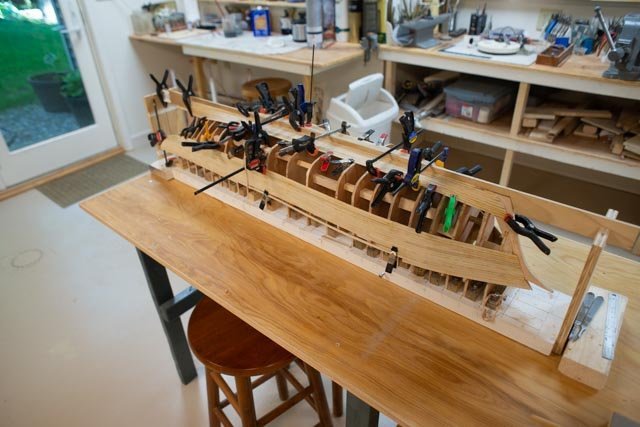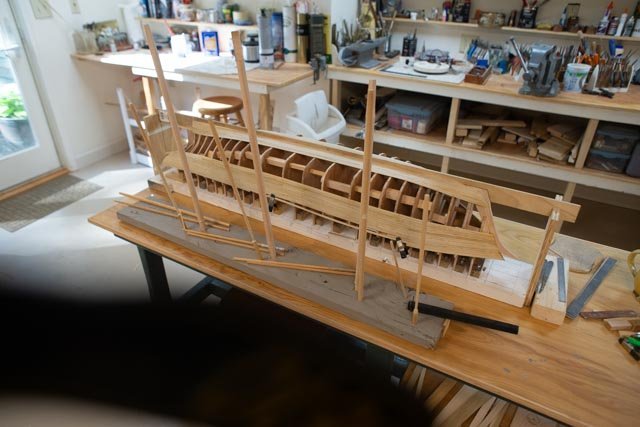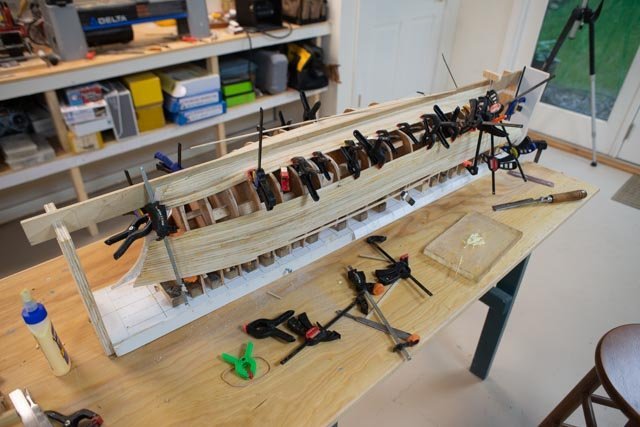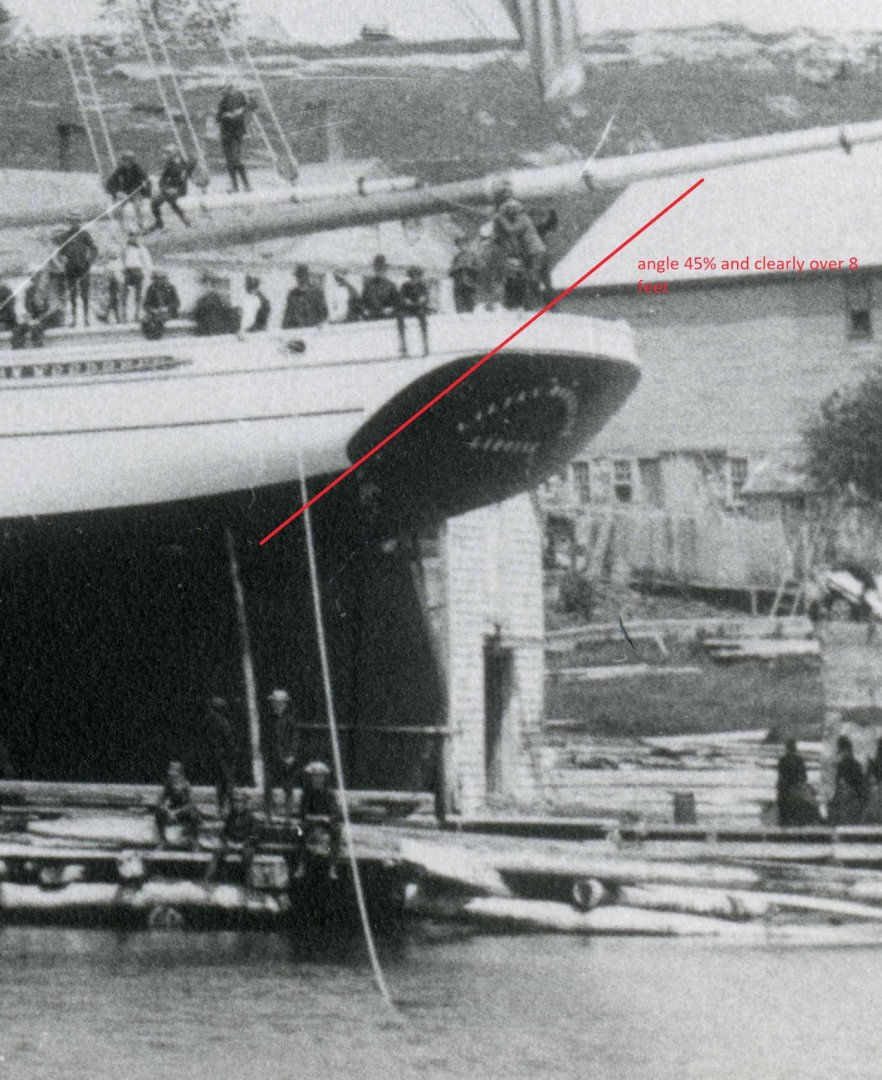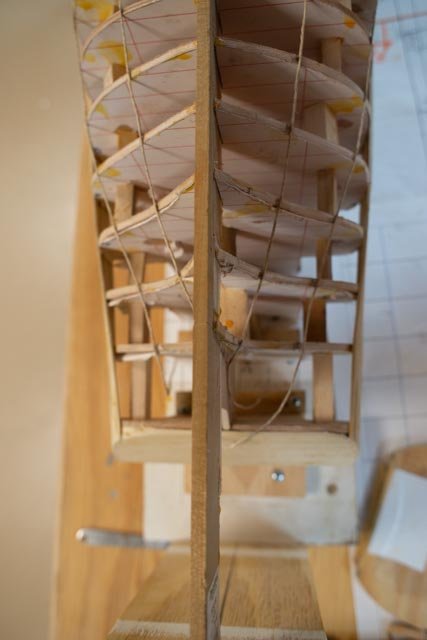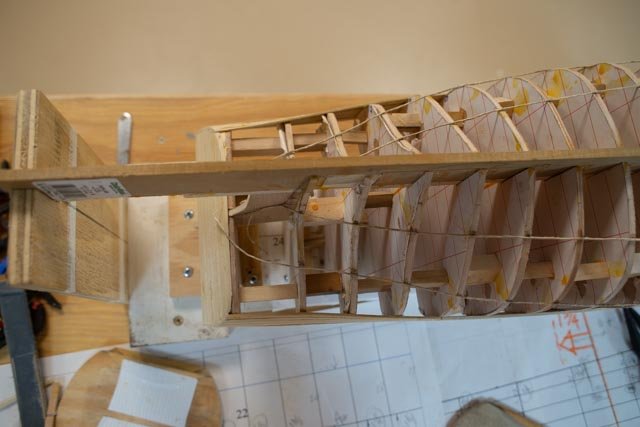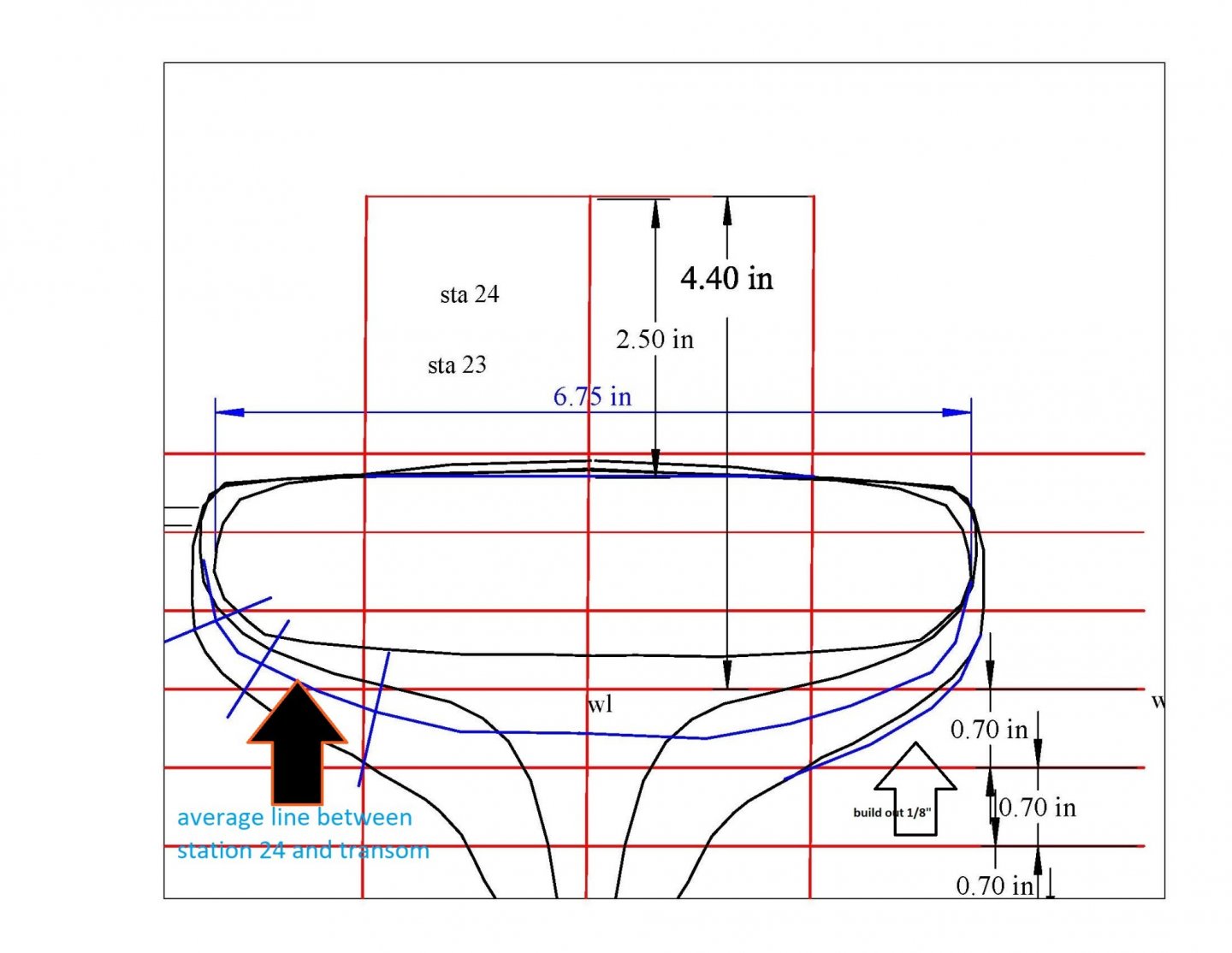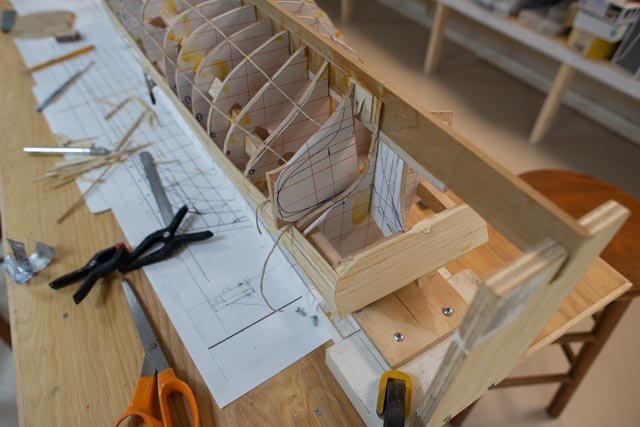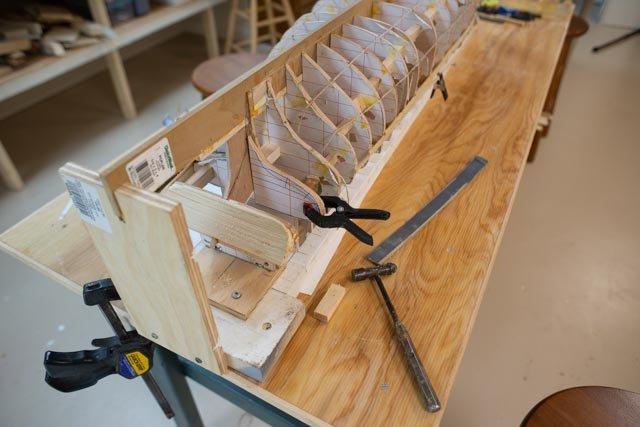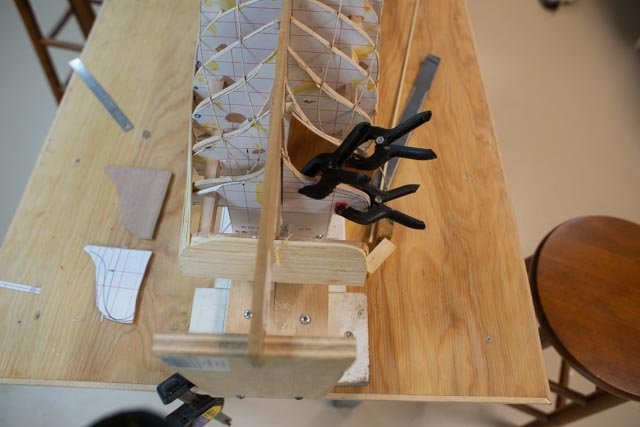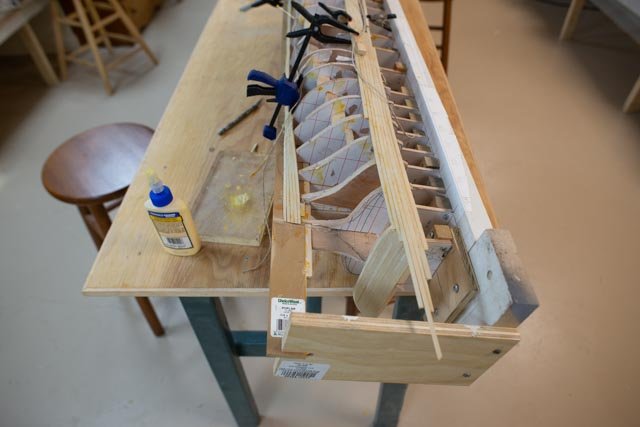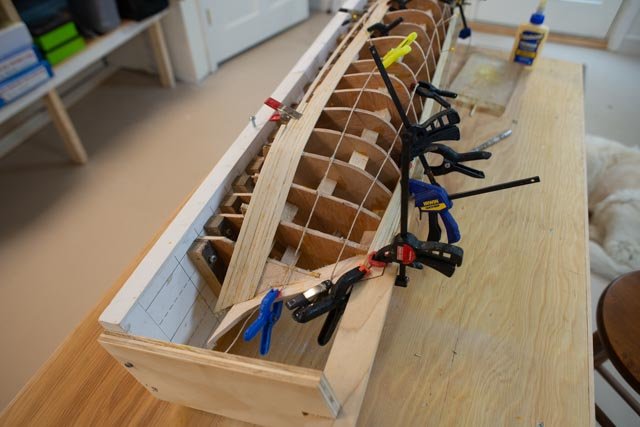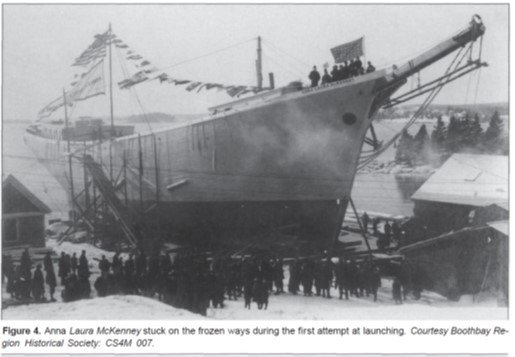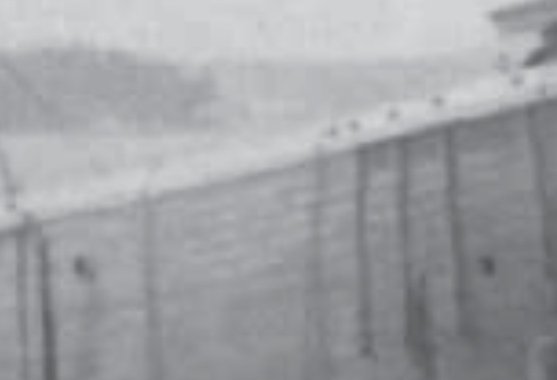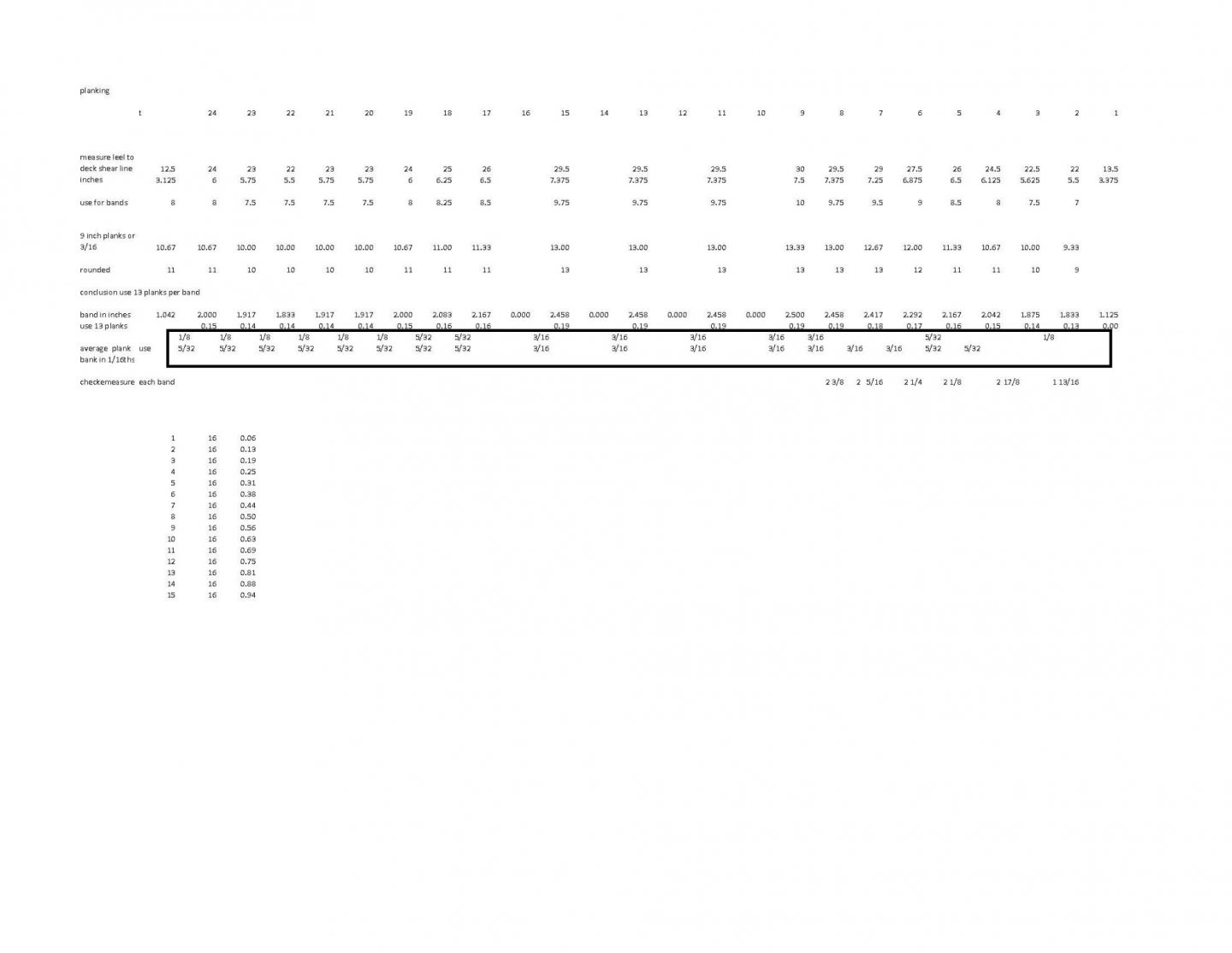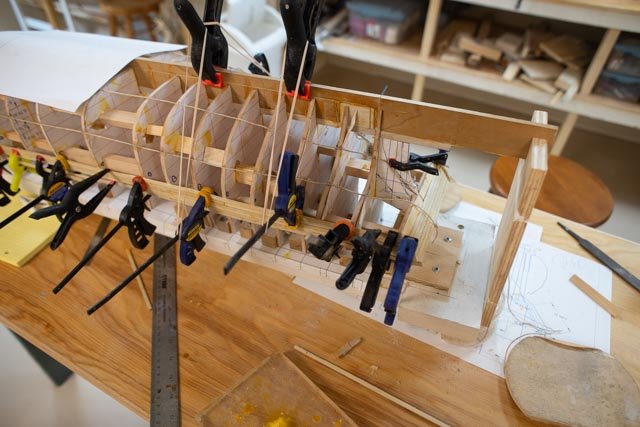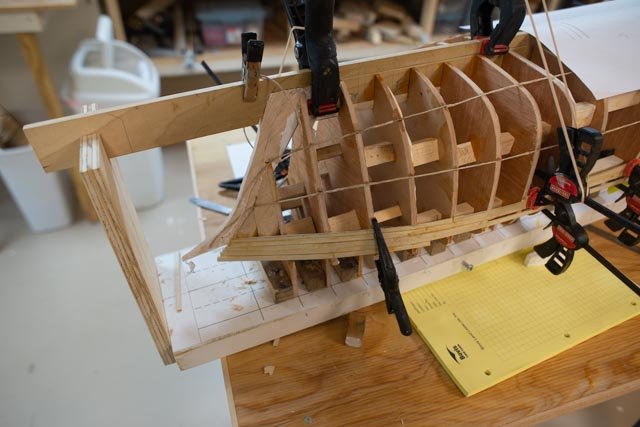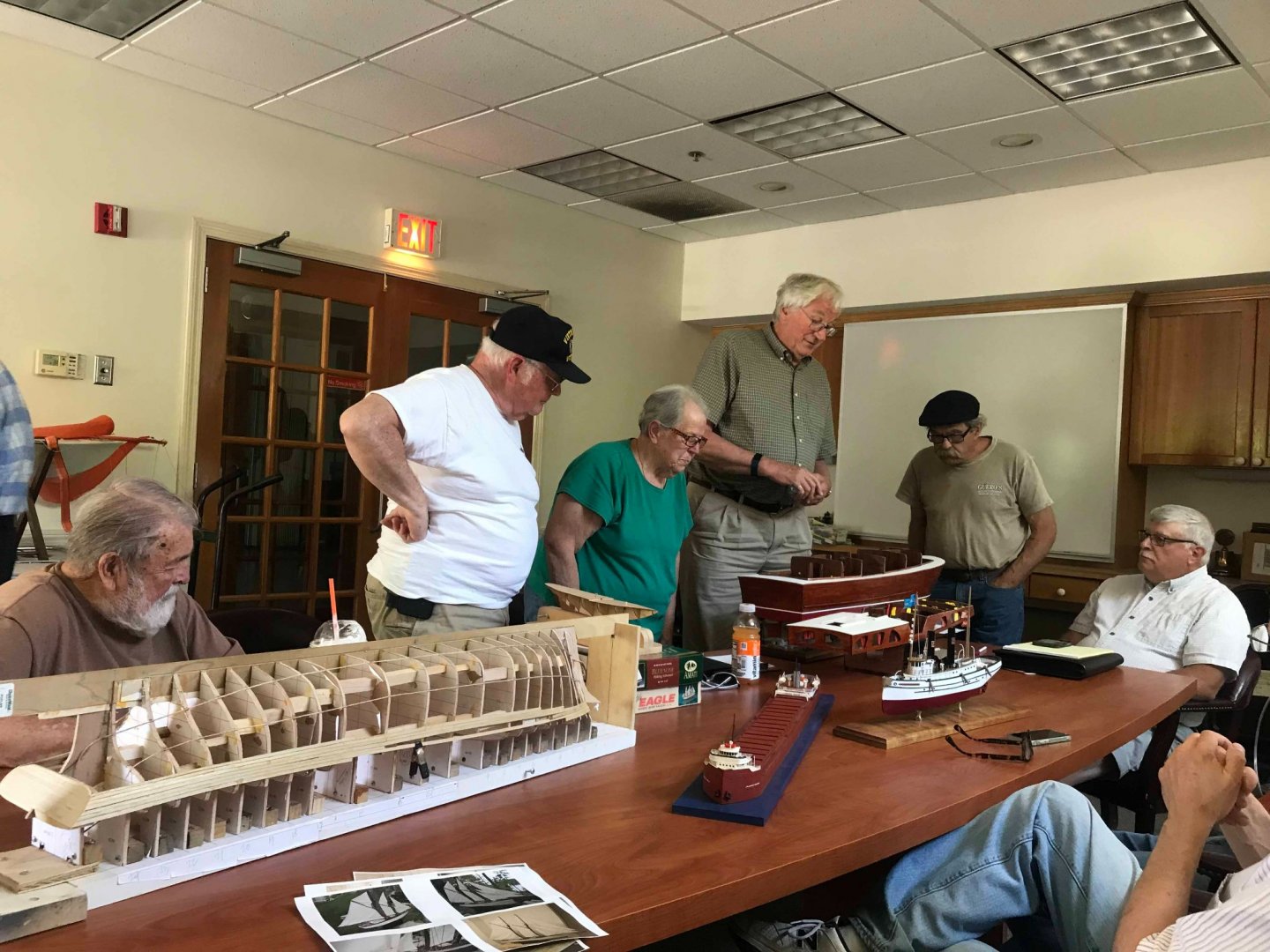-
Posts
852 -
Joined
-
Last visited
Content Type
Profiles
Forums
Gallery
Events
Everything posted by Jond
-
Post 20 First part of fixing the big deck oops and starting production items The first thing I needed to do after deciding to fix the big oops was to add the upper deck across the mid-section. I will worry about the bow later. 157. first up was to mill out, shape and set the new deck beams. The clamps are gluing vertical braces to hold them in place and add to future strength. 158 here we are gluing the new deck beams in place. 159. this is the first view of the new overall effect of one deck. 160 here we are fixing the waterway at the bow. 161 here all the beams are in, the waterway is set, and first coat of paint on. 162 this is a fun shot as it shows what should not be. Obviously, there is only one deck in this schooner. The lower main deck with its waterway and bulwarks is still there but not what I now believe is the right configuration for Ada Cliff Production. making those little parts During these projects that are several components to be prepared. Sometime we simple buy them like blocks and sometime we need to make them like turnbuckles and balustrades. Just to show that the work is now begun here are two views. 163 this view is from previous study and my build of the schooner Charles Notman. We see the balustrades come forward as far as the poop deck. On that schooner, it was very unusual as the poop deck came all the way forward past the main mast. Regardless, we see the difference of the main deck and raised deck. We also see the turnbuckles I made as part of that build. 164. here I am using a similar technique as before to start making the balustrades. I am using maple this time to turn and shape them using files. We need about 100. So, a few each day is the way I try to work. 165. here is the first pile of blanks. 166 here from my past build we see the main turnbuckles. I have found more photos and they all show about the same sizing. The main deck shrouds our held by roughly 5 maybe 6-foot turnbuckles. we need about 70. 167. here on the top mast, they were a bit smaller. I tried to make them 4 feet. [ Note Charlie was a sailing rc schooner thus the muslim sails] 168 looking at the launching photos of Ada Cliff, we see the turnbuckles and the chain plates are about the same size. I will go with 5.5 the compromise feet for both. Now I want to improve on the fabrication that I did before. 169 starting off I am where I was before. Here I am soldering the clevis. I am using a bent brass strip and a 0 hex head machine bolt. The steel shroud will be spliced to a pin in this clevis. 170 I am doing here again what I did last time. This process does not get the look I want this time. I solder a small ring into the end of a screw top machine bolt, that I file to the best shape I can. I have since rejected this method and will show results next time. 171 here is the assembly of the unit. The two ends are stuck inside a small brass tube that has been filled to open the sides. cheers
-
Post 19 Masts are stepped, waterway is done and first painting to get ready for deck is started and then another oops! Every once and a while a real brain cramp shows up… then again sometimes more research comes into play and we realize our earlier assumptions need to change. Let’s see what it was this time. The first issue is a minor brain cramp and it got fixed. The second one……… Following the plans I continued to make some progress…….. 144 here we see the foremast is set through the cabin. 145 here all three masts are set, and their tops have been adjusted to be the same height. 146. this shot is for the record. At least at this point the three masts lined up well. We’ll look again after all the rigging is done. 147. Here is an experiment. I have set the 8-inch seven king planks between the hatches. Next up I will need to sort out how to stain them. So far so good?.... Absolutely not!.............Two issues have cropped up. One is an error in building cabins. It’s no big deal, but the other is an overall concern for the basic design of the deck level. As to the cabins, I made up templates for the sides. I got them all on, but things looked odd. Back to the books and sketches and recheck the height of these cabins…….oops 148 remeasuring I found all the posts on the aft cabin are 3/16 "too high. That will not do 149. here they are cut 150 here they are reglued 151. here are the templates on the fore cabin. It was not so bad. It was level and not following the shear line, so the aft post was high and the next two a little less. They were cut progressively to regain the right slope, parallel to the shear. 152 here they are being reglued at the right height. Fortunately, all this cutting and gluing is under the cabins and out of sight. Now for what I consider the big oops is for the deck construction. There are two opposing concepts in these big schooners. • in one the main deck located at the shear line carries through the schooner. Then the poop deck and fore decks are raised above it. That is what the Priscilla Alden plans and the Bertha book show that I have been following • in the other concept, there is only one deck level. Now that I have all these photos to study of multiple schooners, it seems that where the balustrade fly rail goes all the way forward to the fore cabin. That seems to happen because the deck is high throughout. 153. this view is from the book Fly Rails and Flying Jibs . I have been going over more and more views. This view clearly shows the balustrade rail goes with the fully raised deck. There is no poop deck. 154 this view is what I was building based on the drawings I was following. There is no balustrade fly rail along the length of the main deck OOPS 155. here we are right after launch. The fly rails go all the way forward. One can see people leaning against the rail back at the main shrouds. Another detail that I understand now is that there is no indentation of thinner planks making up a bulwarks above the shear line of the main deck. I have been curious about that detail for some time, as the photos show continuous planks all the way up. Now it all makes sense. there must be only one deck level. 156. here is a broadside cropped picture taken after the launch. My conclusion is that I need to fix this oops before moving ahead. If I use the photos of the schooner I am building, I believe I need to stop and fill in beams all the way to make one deck level. It makes no sense to continue as I am, because I would not then include the fly rail that is clearly in the photos. Arge
-
Post 18 Research update and progress with underdeck Now to share more of the research documents needed to avoid wild guessing. 134. from the Bertha Downs book I used these two pages for the rudder assembly. The left page shows the total ‘cut in’ aspect of the pintle and gudgeons as mentioned earlier. The Right page, left image, shows the parts that are visible on deck under the gear box house, that I hope to replicate. 135. This is a new book. It is called Fly Rails and Flying Jibs. It is based on an incredible collection of photographs taken of schooners. It is helped tremendously by the writing of Douglas and Linda Lee. Douglas I am told is a Naval Architect who through the main Maritime Museum recreated drawings and details for Schooners including a four masted[ Charles Notman}, five masted {Cora Cressy} and the six masted Wyoming. These comprehensive plans and details are critical for anyone looking into these schooners. As a couple they also owned and sailed the windjammer Schooner Heritage for many years. The book is an incredible photographic resource specifically for new England Schooners. There are also many pages of photos and text all about Boothbay Harbor, the center of significant schooner activity. The Boston firm Crowell and Thurlow used the marine railway in Boothbay Harbor and the adjacent acquired land on McFarland point as the center for building many four masted schooners and subsequently providing the maintenance until their failure in the late 1930’s 136 This view is typical of what can be seen for making decisions on what to show on the deck. This is especially true if one wants to model a schooner that was not just launched. The mast was clearly painted. I use this tone to compare with tones on the cap rail and pin rail below as I need to decide how to paint things. 137 this is a similar view from another schooner. The main deck bulwark is what I am building, the simple poop deck enclosure. I love the little porthole. 138. here we are looking forward. The deck planking that the Bertha book told us to make 4 inches and it looks right on in this shot. It is darkish and dull. I need to do that in stain if I want the jointing to show through. This cap rail in this photo is lighter in color than others. It is more like a gray popular on fishing schooners. Another important detail is the turnbuckles. I made them previously on Charles Notman. I will use a clevis on the top and a ring on the bottom. I find that orientation interesting as using the previous info building Charles Notman they were the other way around with the clevis at the chain plate and the ring on the splice…we all live and learn I share the next photo for fun. It is a mystery. 139. The original photo was included in Jim Hunt’s four serial articles in the Nautical Research Journal, on page 218 Vol 43 No. 4. Which was December 1998. It was credited with a file number from the Boothbay Region Historical Society (BRHS) but cannot be found at BRHS. I took this photo in the Windjammer Emporium Museum Store downtown where my 3 previous builds, all dioramas ,are displayed. It is a huge blow up that was done two years ago. There must be a digital file somewhere. It is important, because this is the photo that shows both Ada Cliff and the keel of the first four masted schooner, Marguerite M Wemyss. One week later…. Well, a little luck and thanks to the owner of the museum store we have recovered it, and I have a nice high-resolution version to use. The Original I learned belongs to the Penobscot Marine Museum if one wants to acquire a copy. 140. here is a cropped blow up showing the keel laid for the first four master based on the lines of Ada Cliff, the Marguerite M Wemyss. Ada’s Bow sprit is on the right side. progress update I continued to work on the fore ward cabin so I could step the mast 141 this view shows the dowel leading to the centering pin. 142 shows continued progress with the chock rail. 143 it is always fun to get that waterway on the transom. Now I have to think about all those turned balustrades. All for now.
-
Hamilton I enjoyed reading through this log yesterday. I concur that cleanness and sharpness is wonderful. I am excited to hear your plans to go back to Bluenose. I followed your build closely when I was building my 1:24 Bluenose a few years ago. I still have a few detail on her that I hope to get to this fall and look forward to looking in on your work too. cheers Jon
-
Jim thank you I have enjoyed watching your work too. Ben Latham was one of my first models . I chuckle when I look at her now. The Dove is truly a fantastic project. I built a diorama of the first Hodgdon Pinky , built in 1816 a few winters ago and have drawings of another one built locally in 1834. I will share reference to it on your log one of these days. I have a few other projects before I get to that build. jon
-
post 17 continued deck work and planning I continue a little each day with the steady production needed to get through all the preparation for the deck. Some folks put the deck on first and then try to paint around it. I like to think of it as a floor in a new room. Let’s get all the surrounds done and painted and then lay the deck. 128 While progressing with the waterways, I am setting up to set the mast steps. I also am picking off whatever underdeck items I can like the cabins, quarter bitts and rudder. The hawse pipe holes are now in, and I need to run a little tube to carry the chain. so much to do. 129. Here is my setup to set the rake and check the heights of the lower masts. The hung board over the model is set level. I can then measure both rakes and tops. The tops all need to be the same height and the setting of the deck level was a theoretical dimension. Let’s see how I did………I had to cut one ¾ inch and another ¼ inch…not bad 130. here we have the spanker marking on the board. From the Turbo cad I measure the rake to be just 2 inches at. 28 inches above the deck 131 here on the deck, the dowel projects down to a plate where I mark for a centering hole [ the mast step]. 132 As I progress forward with the waterways, I need to build up the roof of the forward cabin to receive the foremast. I have also have been infilling supports to catch the ends of the deck planking where it will run into the waterway. 133 and just to balance out production I have started stripping the center 7 planks from the cedar stock pieces I milled earlier. These are to be 8 inches wide in scale, just under 3/16”. I will need to build in the quarter bitts and the rudder assembly as this work progresses before I set the planks. All for now
-
Joe thanks again for sharing. Considering the time you must have survived the old Wiscasset bridge. It was not replaced until 1979. The two four masted schooners , Luther litter and the Hesper were beached there and the familiar landmark. They are also gone now. the photo came off the internet today. I have been coming here all my life. My Parents retired to the same Damariscotta you mentioned. My family followed with summer homes and eventual was able to move to the harbor here in Boothbay where I always wanted to be. It is definitely special and a joy. The main Maritime Museum in Bath is a fine beginning for a continuous maritime adventure if you get back to the mid coast. jon
-
Joe Thanks for sharing your fun experience near here. I have spent many hours over there on the next point watching breakers and even a few whales off the Pemaquid Lighthouse. FYI there is a long story of how our town was renamed from Townsend to Boothbay. It occurred in that foreign state of Massachusetts. They were part of Maine back then. The town fathers wanted to incorporate and sent a crew off to the far away courthouse to register. When the crew came back the town had been given a new name of Boothbay. There is no definitive reason why. There was a family known as Beath who owned a lot of land. One guess is the court insisted on changing Townsend and asked for a major feature.That was the Bay. In the end they named the bay perhaps after the family, but no one could spell it. anyway thanks for your kind words. jon
-
Post 16 Deck frame and fix up shear line I mentioned in an earlier post that I was not totally confident that I nailed the shear line while working upside down. Well, I found my prediction was right when I started checking things out. to get things closer to right, l did the following repairs. 120 f. irst up was to compare the two schooner drawings and photos for the angle of the bowsprit. The consensus was 18 degrees. So here it is fixed with a shim. Filler and paint to follow. 121 here I added a plank and tapered it aft. This added plank gets us to the top of the bowsprit. 122. I have talked a lot about the changes made to the stern to replicate the photos. Here a full plank was needed to make it all come together. 123 Now we are in a long stage to build out the deck. I need to be sure the mast fits right etc. I scaled up the deck plan from priscilla to use as the basis. 124 this photo show the bulwarks on the main deck. I will share the research that gave me the combination of continuous pin rails next time. I need to fit it, remove it to paint it dark and the bulkhead white before final installation. 125. Here is a progress update. The main deck beams are in, the framing for the deck houses and hatches started and the bow sprit in place. As I mentioned before I have milled up deck material from scrap Alaskan Cedar I had left over from a front porch project. It is laid out in 3/8” wide strips read for trimming down to the two plank widths I will use. I wanted to share a detail I picked up from the Bertha book. It agrees as well with some photos I have, and I will get into next time. Most of the time we are used to soldering the little tube and pin on the outside of the gudgeon and pintle. Therefore, there is little cutting into the rudder, and it sits back a little from the stern post. 126 here I have followed the instruction for the large size rudder to replicate the band going on the outside of the assembly. 126. There is more undercutting of the rudder to make this work as the pintle is totally within the rudder. That approach tightens up the space between the rudder and the Stern post. The rudder and stern post must have some combined taper/ rounding to avoid binding. all for now
-
Post 15 Milestone we are off the building board! After numerous coats of paint, I have started getting ready for the next stage. That means figuring out the deck. 112. I have taken the plan from Pricilla Alden [ the only one I could find] and set it to the 149 foot scale. I then measured all the key elements to use as a starting point as I lay out the deck. Since Priscilla was built in the same town in the same year, I feel good about finding it. I have a few glimpses of the deck in photos that I will use when I get that far. The basic layout however was quite common. The large print out is to the model scale. At the full size I can use it as a background for layout when building the components. 113. first up are the deck beams. I have done this many ways and thought this time to make a jig and then shape all the beam tops for the right camber. Only 6 beams need to have the bottoms done as they may show if I decide to have loose hatches or where the deck is raised. The others I leave straight. According to the Bertha book, exposed hatch beams were 14-inch, so that was the goal. Just over ¼“ deep. All beams are ¼ “wide as that gives the best support for the decking. I am putting in enough beams to build the model and not researching to have every beam and all the different sizes as I did when doing plank of frame on my last Schooner. 114. here I have made up all the deck beam material I will need so I can go quickly when the time comes. Next I will study how and where to build the clamps . 115 I have made more progress on the spars. My goal was to work parallel, so when the time comes, they are ready. 116 here I have sorted out the different coloring I am using for my attempt to replicate the masts. Now a drum roll. I have decided to stop painting the hull and move on. I obviously will do some damage and touch will be necessary, but I feel I did enough for now. 117. here we are with tape off and the waterline touched up. I have purposefully kept everything in a gloss for now. Most models are displayed in low light and for now I like the highlights. I can always tone it down if I change my mind. 118. and Ta dah! The building board is gone…… 119. and here the rough-cut removal of the bracing that interfere with the build. There is a lot more detail work as I lay out the clamps for the deck beams. This first cut was with a utility tool. It was crazy to use but efficient. I only put one small hole through the planking for my first touch up. All for now
-
Post 14 I am going to paint the hull! There are maybe 10 coats of brushed on and sanded gloss white acrylic. One issue is that white paint is slow at covering red glazing putty. I am using up the gloss as it shows defects more clearly. I think I am done with that stage, the priming, I may want to go with a satin finish and few more thin coats. I am trying to end with a smooth brushed on method and save the airbrush for next winter when I have time to learn how to use it. 104 here is the hull at this stage. The light pencil dashes show where the waterline will be located using the Bath built model information. Checking against the photo 77 above I was happy where it is on the side. I was not yet comfortable overall especially at the bow and stern. I did a little more checking in the bow and stern area. I went back to the Historical society and got a few more photos that helped with the following review. [ low tech as it may be] 105 I placed the bow photo in excel and made a simple rectangle that measured the exposed bowsprit. That is also a known dimension from the rigging plan after scaling. The second copied rectangle is located to show that the distance down to the waterline is the same, roughly 4 inches or 16 feet. That makes the anchor about 9 feet. 106 does the same thing at the stern. The result was to lower the waterline about 2 feet [ ½ inch in scale]. Now it is time to play again. I will soon be cutting the hull off the building board. What type of stand makes sense? I love the models that use acrylic or other media to replicate the sea. That gives us a view of the schooner above and below water. In Bowdoin I used colored bubble Acrylic, I let the viewer see the sea bottom too. I will start with that option available. I can always abandon it later if it become unwieldy. 107. here are two cradles made from Station 9 and 15. On the table is a new print out of the plan view. I went through in cad and measured every station at the waterline to give me a point to start cutting out the Luan Plywood. 108 here after several hours we have the water surface as depicted by Luan plywood. The cradles could become supports for the water surface as well. 109 here for review I have turned all right-side up and share the look I love to make. The bottom is clear under the water level and the hull proportions are much more pleasing to my eye by being only above the water. If I change to acrylic, it is even better. I then must consider the size and how big the display might become. I also fear the cost of the acrylic. It was hard to find for Bowdoin and $$$ 110 the possible bow shot 111. here we go with the first of probably several coats of bottom paint. I am still a low-tech guy that paints and sands and paints and sands and paints eventually gets to a surface I can live with. All for now
-
Allan good to see you dropping in. I have been away a bit sailing and doing that wonderful summer thing. I was off to the Historical Society last week and found some more images. I also couldn't find some I know they have, so more to do on that one in the fall. I agree the research is much of the fun. Also staying with the theme of Shipbuilding in our harbor lets me find more and more cross referencing. it's all good. even if I build an ugly Schooner, I will gain a great library. I just ordered the book you recommended for the sail making. I 'll update after I read it ' thanks again jon
-
Thanks Allan ordered the book today and will look at the video cheers
-
Allan after seeing your Boothbay Schooner I am game to trying this method out. I am look now for more tutorials cheers jon
-
Post 13 Closer to painting the hull and more work on spars I had to laugh at myself as I reviewed photos in the log and found I mislabeled one as the Ada Cliff; that was wrong. I have several photos in the archive, and I pulled the wrong one apparently mislabeled a few years ago. The substitution does not change, but reinforce my conclusion, I just thought I should set the record straight. I also edited the earlier posts identifying the other Schooner. 95 here is the photo for which I need to get a larger scan to allow blow ups for more details. It shows the white transom on Ada Cliff. The larger size and closeness to the 45-degree slant agree with both Priscilla Alden and Lillian Woodruff. All is good. The waterline painting and spar finishing One bonus to the above photo is that in the lower left, one can see the keel for the first four masted Schooner has been started. The yard alternated building one after the other for the following few years. Back to painting the waterline, I see here in the photo that the sharp rise in the transom may be more of an angle than I achieved using, and then then modifying, the Bath built Schooner drawing. In my preliminary check, the waterline will not be quite so low on the rudder. That would suggest that despite my efforts the shear of the transom does not yet swoop upward. I hope to be forgiven once again if that pans out. The following image and blow ups are from the launch day newspaper photos, now available at the Boothbay Region Historical Society. They will be the basis of my attempt to make this all work out to be representative of the actual Schooner. 96 this view is the overall shot. After I lay out the waterline, I need to determine if another bulwark plank may be needed to get the rise in shear at the stern. I hope not, but only time will tell and only the few readers of the log will know….smile 97 In this blow up we get a sense of dark and light for treatment of spars. The mast in the hoop area is darker that other photos. The Boom Saddles are clearly white, but the yokes are natural. The hoops are a lighter color; perhaps they’re ash or white oak strips. 98 This view shows all the bow sprit and its rigging and trim. Also, the anchor shape and size are clear. This view at this point will help me identify the right waterline. It is clearly a big drop or better se=aid the bow shear looks high. 99 here are the fore and main top masts. All of the spars seem to have remained natural. The cross-ties look to be dark. As they as typically made of oak, I assume this work was all painted black. The iron work is clearly black, not galvanized. 100 here is the Mizzen top. It gives a clear view of the rigging and will be helpful at that stage. Now it just confirms the dark finish. With these photos not at high resolution I still believe I can move forward finishing the spars and finishing and iron work. Before I get into the rigging process, I hope to get higher resolution photos and pick some more detail Back to work 101 here I am setting up the two types of blackening I am trying to perfect. I am using the kettle with Sparex for pickling and Brass Black for brass and Liver of Sulphur for copper. The first fittings are on the spanker boom. I am leaving them loose until the mast is stepped and I line up the sheet band. I dare not fix it in now. 102 here is the brand new, never used spray paint set up my son recommend for the amateur that I will be. I need to break in to avoid the issue of brush strokes with acrylic paint. 103 here is an update photo of the spar building program. I keep working on the different areas. I need to get the lower masts finish right and then the hoops on. Once that is done, we begin the crosstree building. In the meantime, there is a lot of brass and copper iron work to do. I have sanded the hoops to where they still have some strength. At some point I need to stop and go forward. I still need to look into getting some veneer that is flexible enough and stable enough and then find how to cut narrow strips. The birch works ok but a paper think it slides under the saw fence. May If I keep scanning logs in the how to do I will find on on making better hoops using wood. All for now
-
Post 12 Think about hull painting and progress on spars First up was our monthly Guild meeting in bath, City of ships. 84 the tug sitting next to the Ada Cliff hull is awesome. The detail amazing and yes it will motor around a pond this summer. Thus another discussion of whether to sail Ada Cliff. The group was kinder to me since I fixed the incorrect stern as reported last month. They thought my idea of scratching little lines on the planks was nuts, as they would never be seen under paint. One thought the planking on fast built coal schooners of 1917might not have been too perfect, so why take out all of the dents anyway. It shows there are many choices out there when deciding when to paint and more forward. As a follow up, my son visited and convinced me to buy my first airbrush. It comes in a few weeks, and I will obviously need to practice some before using it. Therefore… 85 here I am going over dents and things with more glazing putty and sanding vigorously after each coat of paint. The hull is resting though with so many visitors as well I am therefore going ahead with the prework on spars and planning for sails How to rig a large scale schooner….could it sail? The milestone reached by completing the planking means many things need to be decided. I want to share a photo from my 2015 model of Charles Notman. It was a similar 1:48 scale Maine schooner. The big difference is I definitely built it to be an RC sailing schooner. Let’s look at some of the decisions made to support that approach and see what I need to do now. I do not plan to sail this model. 86 Charles Notman model foremast details. There are many things to look at here and then decide if they are appropriate. Also, as all of us learn from our mistakes what improvements can I make 6 years later. 1. Mast coloring and hoops. As this was a RC model, I chose thin 1.5MM brass hoops. They aged nicely and since it is a sailing model maybe OK. 2. The mast is Sitka Spruce stained dark. it should have been dark only in the area of the hoops as the mast was greased there. Having sailed on Bluenose II and seen many Maine Windjammers the mast is its natural color away from the greased areas. Some are painted from the boom saddle down and cross ties up. 3. Sails were sewn muslin. There is lots of info advising anyone at this scale not to use cloth or sewing machines etc. Since “Charlie” was a sailor, I still feel that gives it a pass. I will not use cloth. I hope to learn how to work with Silkspan on this go around. 4. Turnbuckles. I used brass tubes filed to make yokes and small machine bolts for the ends. Obviously, half of the threads are not left handed, and they do not work. They were painted Aluminum paint to give the galvanized look. What I plan to do will be similar, I just hope a little better soldering etc. 5. Balustrades. One hundred plus and I turned them with files on a small lathe. I assume the same and again just hope for a better consistency. I have also become a little more selective in woods. So, let’s get started with the rigging plan for a static model. I still hope to get the running rigging right and that is a key interest I have. We need to be able to keep the understanding of how these big elephant-like rigs worked with such a small crew. 87 first up is the boom saddle. I usually sin again and make these out of plywood. Drill the center hole and then sand the outside of the doughnut. 88 here I show what I am not going to do. I struggled to find more of the 1.5 mm smash rings and came up with these. They are thicker! Great for out of scale RC sailor. They are going into storage. 89. here is the start of what I hope works out. I use 1/64 birch ply and cut strips. I find the saw strips the bottom layer, so with that I dare not cut any narrower. I will need to sand them down and I am not sure how narrow it will come out. 90 here I have selected two sizes of tube to use for the hoops. This schooner used them on the uppers as well. 91 now for all those little bands. I learned this trick from a clipper ship log last year and it works. This little box contains what I am told dentists used years ago for making inlay molds. There are 14 diameters of thin copper tube. One is on the tapered dowel by the X-Acto knife, I cut the bands by rolling it. The bands then find a nice snug fit. Occasionally for the smaller end we need to cheat and add a dab of glue. Once the annealed steel wire eye goes through the spar, all is secure. 92 here I am drilling through for the peak halyard hardware for the wire eyes. 93 here I am soldering the little rings to make up the linked hardware for the throat halyard 94 here we have a progress look as we work our way through the foresail spars. For look only I put three of the old brass smash rings like Charles Notman and then three partially sanded hoops. Considering that the hoops will not be bunched below the lowered gaff, but sewn to the sail, I believe they can be a little bigger than reality would dictate. I hope so anyway. All for now
-
Thanks Tom it is always fun to get those last few planks installed now the issue to ever get satisfied with sand and clean up to go ahead and paint. cheers
-
Post 11 Complete planking As most of us have learned the hard way there is no simple answer to hold that last few rows of planks in place. I have learned to simply improvise as I go. 75 here I took a block and passed the string through the hull and clamped it to a bulkhead on the other side. A little wedge and all is good. 76 here we are done for the lower section. 77 There were several areas that I thought to fill before sanding thus confirming my limited ability. Now I need to get those bulwark planks in place and not glue them to the bulkheads. I could have waited I suppose but I believe this is the right time to complete them. 78 I cut away the top corner of each bulkhead and then used scrap and clamps top act as temporary stanchions. 79 I learned before that it is handy to get a prime coat on to better see what I am dealing with at this stage and not wait . Before the paint that I razor cut along any joints that I filled as I hope to get enough joints showing through the paint to see the planking. 80 here the top bulwark plank is in place, sanded and primed. Now to do the other side and add a second coat of primer 81to 83 sanded and primed. Now comes a few days of going over and adding a little filler where needed, sanding and trying to get a better grade before marking the waterline and painting the bottom. I also need to add many little cuts to show the ends of the planks after a sanding and before final painting. Next up I am working in parallel to get all the spars ready All for now
-
Just a few updated photos as I started the final planks just before the holiday break. Lots of sanding and scaping of glue ahead of me cheers
-
Post 10 Continue hull and spars and research on sails I believe it is important to record where we combine ideas and sources especially when we are making it up as we go. One of the best books for a Schooner lover is the wonderful book The Schooner Bertha L. Downs by Basil Greenhill and Sam Manning. A note on the cover also identifies this book as the anatomy of the Ship. I love that because there is a running argument that a Schooner is not a ship. There are many other drawings by Sam Manning and other information available through the Maine Maritime Museum of note too. MMM in Bath, Me is a must stop for those that get up this way. Basil Greenhill has other great books too. Part of the fun of these builds is also the growth of the library . 68 The Book retells the history of Schooners and then takes us through every detail of this wonderful vessel build around 1909 in Bath, Maine. We need to remember that around this period, the famous 6 masted Wyoming was launched, it was the end of the schooner building boom. It was 7 to 8 years until 1917 when so many freighters were sunk by the German U boats, that people realized the resource of skilled people, materials and facilities in Maine to build many Schooners. That combined need and supply source led to the boom in 4 masted schooners that lasted about 5 years. As I said earlier in the log, the Ada Cliff was used as a model for 4 four masted Schooners. The only change to the first one was to add 40 feet and a fourth mast to the lines of Ada. I repeat this because the detail of the four masted Bertha l. Downs is therefore very appropriate to compare with the three masted Ada Cliff. I will not place lots of details from the book that I use in the log but will declare that masting and rigging is be based as follows. I am copying the scaled sail plan of the other 1917 Boothbay Schooner Priscilla Alden and then checking it against the Bertha L Downs drawings . For spars and things there is no way to use the other information, so I use the cad scaled drawing for lengths of spars and sails and the book for everything else. 70 here is an updated progress shot. All the spars are roughed out and I am in the second stage of adding yokes drilling holes and thinking about cross trees. I need to get more photos to determine the extent of painted spars too. When I studied the Charles Notman, built in 1894 in Bath, Me., they used jack stays for the topsails and not hoops. That is similar in logic to using a spanker mast on a ship. I note that Bertha L Downs shows hoops on the upper masts so that is a way to go. Continuing spars Now that I am using the details form the book I am able to get going. First up I found I needed to take down all three lower masts to get to a smaller diameter. Second up is to start making all those little yokes. 71 I learned a while agio that to make straight little drill holes it is best to use a mill. After learning that I found it natural to go over and set it up. 72 this also helps in glue up to be able to use pins to align the parts I am using maple for the yokes. . Start of sails Sails take a long time. The first process is to develop a set of templates. That is all I am doing now. 73 here I have taken measurements from the Sail plan in Turbo cad and laid them out on a sheet of newsprint. I made simple coordinates. 74 here is the detailed sail print from Bertha L Downs. It is fun to check especially as they seem to be similar. When I measure the foresail and fore topsail, they are right on. The head sails will be different and of course we are missing one mast. Up next is Planning the middle band of planking It is time to recheck everything and plan my attack. As an amateur I can say I am ok if the bands on port and starboard are not perfect. They are off on one side to the other about a 1/16 on average. The bow is right on as I could look each time. The stern is over a 1/16, so I need to fix that . we will see how it goes next week. I am sure as soon as July 4 arrives, we will slow right down though, so I do not have major expectations as when to celebrate the last plank. All for now
-
Post 9 Start the masts and continue planking I found a few years back that I love using Sitka spruce to make large scale spars. I bought a good supply and will be able to continue that practice. 60 I started off this time by making a jig to hold the square cut strips to make that first corner cut. 61 here that cut is made. I then carefully adjust the fence and make the three other cuts sliding the cut side on the table. 62 I chose to do the foremast first as it is the shortest. It fit in the middy lathe. Yes, I am taking a short cut using the lathe to make round spars. I agree with eh hand method in small scale but continue my ways. 63 here I have sinned again by selecting dowels for the other smaller spars. Once they are shaped, stained, and all and sails are attached, I am comfortable that not using the spruce will be OK. 64 when it came to the two longer masts I needed to cut the below deck portion first to fit in the lathe. I remember the difficulty with the bigger Bluenose spars, so being able to fit the rough cut stock in was particularly good news to me. In the meantime, I peck away at the planking. Another sin is I am running longer planks and will cut in joints later. I do this to get a smother sweep. 65 here we are at the beginning of the week getting close to completing the out two bands. 66 here is a progress update photo showing many of the spars are now roughly shaped and the planking coming along. 67 I can celebrate the first bands are done and the first plank of the center band is going in place. I hope to get through this stage before the summer outside schedule take over completely. All for now
-
Post 8 Fixing the stern again My effort to stretch the plans a bit to make the stern more like the photo of Ada went too far. So, what did I do, what went wrong and how to fix 51 here in a blow up of one of the photos of the 1899 Lillian Woodruff we see maybe 8 feet [ 2 inches in scale ]and the angle is closer to the 45 degrees than the 60 degrees of the bath Schooner plans. I made the transom based on this photo. 52 and 53 looking down and then across we can see the extra dip and twist of the planking that was not faired to the combined new transom….oops that mistake was picked up by my colleagues. So how to fix? 54 playing back inside the cad plans I added a rough polyline that split the difference between the original station 23 to the transom. That blue line is bigger than station 24 55 I printed that drawing out and pasted it to scrap plywood 56 here I used the red Cross sections lines to properly align the new piece and glued it to station 24. This effort gives me more station bulkhead to fair 57 it became obvious I needed to do the same thing to station 23. In this photo I had removed planking only from one side where the clamps are located 58 several days later , both sides are done and I am getting back into the swing of planking. The dip is gone, so I guess we are OK 59 looking from the bow, I am now working top and bottom bands toward the middle. I know from memory I will get to a point of no internal clamping if I complete both bands and then attack the middle. So more to think about as we move along. I need to figure at what point in the curve do I want to be fitting the last planks where only rubber bands and other similar means hold the planks in place. I prefer not to pin them but we are painting so maybe that will be OK too. All for now
-
Joe thanks for the sympathy yes we need to show our work and we need the critical eye and open comments to keep us improving. I have gone past the problem with adjusted stations and will catch up on the log in a bit. thanks jon
-
Alan good to hear from you I learned the method at Wooden boat school many years ago when I went there with my son for a vacation treat of building two Marblehead racing yachts. I have used it on several other larger scale builds . it saves so much effort. cheers jon
-
Post 7 Planking plan This story is lengthening as I have some false starts. The root cause of the issues is having no real plans I am combining photos with a bath-built hull drawing of an 1884 schooner. The impact of my false start is the highly visible stern section. We will get to the oops but first the plan. In my last Pinky build, I went through the lessons learned at the NSJ conference in New Bedford, where we had a great presentation on planking. I followed THE process the best I could and had a reasonable conclusion. My previous large hulls were for RC. That means the hull planking was only a substratum for fiberglass and as three of my builds show, it is fast using 1/8” cedar planks and sanding away. This time it is a large hull and I want the planks to show through the paint a bit. That still allows a few errors to be hidden and for a reasonable rate of work. Sloppy glue will be sanded and painted by example so good old strong wood glue can be used. A major issue will be how to deal with the bulkheads once I complete the outside and turn the model over to start the deck. So, what are we trying to achieve? 45 here is a newspaper photo of the Schooner Anna Laura McKenney build a few hundred yards away from Ada at the same time. She was completed in December of 1917 when a major freeze came to Boothbay Harbor. Everything was frozen. They could not launch her for a month. 46 the point of showing her is in this grainy blow-up detail of the planking. This photo shows that the size of the planks are clearly less than 12 inches. Based on the experience of seeing Ernestina Morrissey being rebuilt on the exact location over the last few years is that 9 inches is a good average to use in the planking. Thus, for the first conclusion the maximum planks will be 3/16th in scale. I plan to use 1/16” thick planking without laborious thickness sanding. The first reason is strength. I want the opportunity to dig out much of the interior bulkheads in case I take that path. The second reason is there is so much planking I want to be more productive and less worried about each placement. There is then plenty of meat for sanding. Next up is figuring out the bands 47 here we have the table of calcs to figure and simplification of plank production. If one sees the box its numbers advise the size of a plank for each zone. It is possible that for most of the planking, since it is so straight, that with more simplified tapering vs each plank spiled we can get there. I am sure at the bow and stern are will we the take off method and spiling of planks out of ¾ “blanks. 48 jumping ahead in what became a false start. I am adding a few tapered planks to the stern. The transom in this photo is also being planked. The three bands are separated by twine. This string option was described in the NJR conference, and I have adopted it. I like that it allows easier adjustment than the use of wood battens. 49 here we are doing the easy stuff at the bow. I had to do the other [ port] side twice to get the two sides to come together at the bow sprit. 50 well here we are post covid back at our monthly guild meeting. We even had lunch. My schooner skeleton is there about to get creamed. It seems using string for setting up bands makes one think there is no fairing going on. The old-style batten is the way to go they mostly said. More important was the consensus that my first attempt to put the right size transom on the old, designed hull was an un lofted failure. I am truly glad they trashed my first attempt. Some time we need our peers to clobber us. I am back to the shop and already part way through the restart. The issue is with the enlargement of the transom [ height that is] I ended up with the two planks that I set on the stern area below the shear planks, reducing to the last station 24 and then flaring back out to get around the transom……oops that what was rejected, and they were right. Next posting we will document the problem and the fix. I do not agree with them on the string however as I understand it is not the same process as the batten fairing that precedes it. Cheers
About us
Modelshipworld - Advancing Ship Modeling through Research
SSL Secured
Your security is important for us so this Website is SSL-Secured
NRG Mailing Address
Nautical Research Guild
237 South Lincoln Street
Westmont IL, 60559-1917
Model Ship World ® and the MSW logo are Registered Trademarks, and belong to the Nautical Research Guild (United States Patent and Trademark Office: No. 6,929,264 & No. 6,929,274, registered Dec. 20, 2022)
Helpful Links
About the NRG
If you enjoy building ship models that are historically accurate as well as beautiful, then The Nautical Research Guild (NRG) is just right for you.
The Guild is a non-profit educational organization whose mission is to “Advance Ship Modeling Through Research”. We provide support to our members in their efforts to raise the quality of their model ships.
The Nautical Research Guild has published our world-renowned quarterly magazine, The Nautical Research Journal, since 1955. The pages of the Journal are full of articles by accomplished ship modelers who show you how they create those exquisite details on their models, and by maritime historians who show you the correct details to build. The Journal is available in both print and digital editions. Go to the NRG web site (www.thenrg.org) to download a complimentary digital copy of the Journal. The NRG also publishes plan sets, books and compilations of back issues of the Journal and the former Ships in Scale and Model Ship Builder magazines.


